#also i found a copy of the european version online
Explore tagged Tumblr posts
Text
I kinda wanted to try and start a new Tomodachi Life save file, but I don't want to delete my current one on my 3DS, so off to Citra I go!
Funnily, when I gave Johan's mii his name, the game pronounces it like it's pronounced in the French version with a j sound lol. So ya have to use the pronunciation setting in order for it to be pronounced in the usual way.
Though in my attempt at making him in Tomodachi Collection, I just stuck with the French pronunciation for him and Peewit. His French pronunciation kinda feels more natural to me when transliterating it into Japanese and I feel like Peewit's French name, Pirlouit, would be a bit easier to adapt into Japanese.
#plus i still kinda like to think the french version of johan's name in universe is like a corruption of jehan which is an old french name#and the choice to translate pirlouit as peewit in the smurfs cartoon was a smart move as the names sound similar#and peewit is easier for a monolingual english speaker to pronounce so it's a win win#also i found a copy of the european version online#johan's voice will likely sound much more accurate this way lol#with the accent difference and all that#it's honestly neat how they changed the accent in the us and european versions of tomodachi life#whereas the japanese version uses the same voice from tomodachi collection#which sounds waaaaay more bitcrushed#reminds me a little of the amiga's text to speech from the 80s
4 notes
·
View notes
Text
Introduction and UtsuKare Translations Master Post
Some of you might recognize me as that Russian translator of Utsukushii Kare books from Wattpad. I decided to revive my tumblr to compile all the links and explanations here for those of you, My Beautiful Man fans, who can't wait for official English releases of the books.
I could never keep a blog, so for now here I'll just tell how it all came about, and you can find links to all my MBM translations at the end (feel free to just skip the wall of text).
So a couple of years ago I finally bowed down and decided to read Utsukushii Kare series in Japanese for language practice, even though I found the summary unappealing and I'm generally suspicious of overhyped media (as far as BL novels go, these books seemed to be The most hyped-up series in Japan). Much to my surprise, I loved it so much it was hard to move on. And while I waited for a chance to buy book 3 and Interlude, I gobbled up everything else related to the series that I could. The manga was only just starting, I didn't like dramaCDs (but I'm in the minority), and the drama somehow revived my love for watching Jdramas, even though I thought that this part of my fandom life has been over for years. When the second season started airing, I made a new friend in the Russian-speaking parts of the Internet who was even more obsessed with MBM than I am, and we fangirled to our hearts' content. At some point I promised her to translate the big sex scene from the end of book 3 as a gift for all the talks. I did, and since back then there was nothing for book 3 in any European language, as far as I know, I decided to post it online and give a link to English-speaking UtsuKare fans too. And since Wattpad doesn't allow copying text, and the browser translator feature from Google Translate was really inadequate, I also put up a link to the translation made with Deepl. As far as machine translators go, it is noticeably more comprehensible, and I didn't have the time (or skills to do the book justice, really) to translate it to English myself. Anyway, after this excerpt I thought I could manage one more important scene from book 3, then one more, and then I finally gave up and started translating it properly from the beginning. I also started correcting mistranslations in Deepl-versions that I kept doing for English readers, so some parts of the book are now much more readable than others. Now the third book is done and I started to work on book 2, Nikurashii Kare. I also translated several stories from Interlude and plan to do at least one more, but that is put on the backburner for now since I want to do as much of the book 2 as I can before book 4 in the main series comes out. Yes, we're getting a new Hira and Kiyoi book! This year too, probably It came out at the end of October 2024 in Japan and, unless something terrible happens IRL, I' plan to 'm thinking of translating it as well.
So here are the links to everything I've translated from My Beautiful Man book series:
Book 3 "Nayamashii Kare" which continues the story past the movie (completed). The text is in Russian, but there are links to decent machine translations to English at the beginning of each part (I've also run through most of them and corrected the mistranslations). Or you can use the in-browser translation feature, but the results would be less readable.
Book 2 "Nikurashii Kare" which was technically turned into season 2 of the drama and the movie, but the script has deviated so much from the book, at times it's like a completely different story (in progress; another 2 updates, and the book will be done). I don't make Deepl translations for this since the official English release finally came out in December.
Stories from other books in the series. The first part is a short scene from Nikurashii Kare, and the rest are stand-alone stories from Interlude. One of them had also been translated to English by Mauli before, but I didn't use her version when working on mine. The rest of the stories have never been translated by anyone else, as far as I know. These, too, have links to Deepl-versions at the beginning.
Disclaimer: my Japanese is not yet really on a level good enough to translate fiction, and there are bound to be mistranslations even if you read the original Russian versions. But I'm cross-checking myself on everything to try and keep those mistakes to minor things. I also know how to translate so I made sure that the text flows well, doesn't feel choppy and retains the same vibe that I get from reading the original.
62 notes
·
View notes
Text
How to print your throam copies in 2024
Since Anna isn't selling throam anymore, people like me, who hate reading on a screen, have to find a new way. I've been a fan since 2022, so in 2023 I discovered throam and at Christmas I printed myself throam copies to be able to read and annotate them. So here's my guide on how to print your own copies.
Get links
Even though Anna's links have been taken down, you can still find and download the links here:
You can also find EPubs versions here
2. Get covers
This may be a difficult one, since the pictures online are rather rare and bad. My way was asking a friend high quality pictures of their own covers (they have hardcover copies). With an online program I cut out the figures and used them to make the cover on Canva. I unfortunately don't have the Canva covers anymore, but I can take pictures of my copies.
I have blank back covers, but you easily add text to them with Canva, and remember to make the back spine as well.
3. Find a site
Now you have to use all this stuff on the site that will print your book. If you are American, my advice is to use lulu.com, where Anna used to originally print them. It's very good and reliable.
If you are European like me, you can rely on lulu.com too, but it may be a bit expensive, so you can also look for local book printing sites. I have found one for my country and luckily got good copies for a decent price, but it was a very unreliable site and I spent days fearing I had lost my money, so trust me and check the site before you order (a good advice from my dad: use trustpilot to check the reliability of the site).
4. Create the book
Different sites work in different ways, but more or less they all have the same principle.
You have to upload the pdf of the book, the site will most likely recognize the format. You will then choose the type of paper you want (my advice is always go with regular, not ivory, because ivory paper is the one they generally use in schoolbooks and it's hard to annotate and read) and if you want a hardcover or a paperback book.
Then you will have to create the cover, so you have to import your pngs (it really depends on the site, but it will either ask a png or a pdf) from Canva and fit the cover outline the site will almost surely prepare for you. It should be an outline you can fill without the help of additional programs, so no worries, once you understand the principle, it's super easy.
Once you've done this, give a look to the preview to see if everything is fine (Trust me, check twice).
5. Order and pay!
Another reason why you have to check the site is because of the prices, some may be more expensive than others, both in the book pricing and in the shipping.
Enjoy your book!
Bonus!
If you like to annotate books, a good investment may be highlighters, markers and post its!
30 notes
·
View notes
Text




I'm still buying DM stuff, I think over it more or less. I bought a 40 years old American collection LP (up here) that I already have in CD (40 years old and American). Is it logical? Of course.
I bought my second Construction Time Again (down here, Made in Sweden) and sold my first one for 12€ (in the middle , Made in West Germany, bye-bye...), because it hasn't got this black sleeve with the lyrics and the paper cover is in really bad condition, though the record is perfect. My 1st selling! Rocks.

I bought an interesting double CD from Taboo Records, seems Hungarian but it is written "Made in Pangea", like the 100 million years old, ancient continent. This is Dream On Budapest!, the Exciter Tour concert in Hungary, 12th of September, 2001. Fans made a short video on the day of the gig about Dave while he's speaking on his cellphone next to the hotel they stayed (it would've been a hard day after the 9/11 attack, leaving his family or friends back home in NYC).


Booklet has beauties, I put one here:



Another Videos 86>98+ DVD (2002) which is double DVD compared to the first edition and the 2nd record has treasures including Condemnation (Paris Mix) official video that was made in Hungary and But Not Tonight's video which song I love somehow, that's why I bought Black Celebration's U.S. edition LP. I have the DVD's 1998 version (scroll down), now could sell it but I need this for the full story: Corbijn finally agreed to put this beauty to the official selection.
First I ordered this double DVD from Antal, I've found it on his shop's website. He went on holiday for whole July and August, so I had to wait until 2nd of September. He was much friendly this time although I didn't buy anything, because he talked me out of it! In fact the DVD has the European bar code on his website, but he has the US version, that I couldnt' have played at home in his opinion. Weird, but I believed him and went home empty-handed.
Than I was searching for it for hours, 22 years old stuff, does it exists in Hungary at all? I found it only at French Amazon. You can bet, after 1,5 months the DVD lost somewhere in Europe, luckily I got back my money after 4-5 e-mails. Without any hope I visited an infamous online used stuff market and I found a piece that was sold already. I didn't know why, but I called the seller by phone, he answered "actually I still have the DVD because I haven't sold it last weekend at the blablabla festival". Wow. On the same day I got it <3




Short report: I have 38 vinyls so far - including a Soulsavers album, 12"-7" together, 5 more singles is coming in couple of weeks. After that I'll sell 3 of mine which are the same pieces but other editions, I prefer British copies if I find somewhere. Also have 14 CDs (with Paper Monsters), it's funny, because I promised earlier that I don't buy one, and actually I need 2 more (Precious and an other edition of Only When I Lose Myself because of its lovely B-side songs: Free and Surrender). 5 DVDs and a cassette and 6 books/magazines (one more is coming by my "dealer"), some pins, shirts, jewelleries and other clothing. Like a teen, OMG. Bizarre. Laugh, I do the same. Happily.
Details (occasionally mixed): #vinyl collection; #non-vinyl collection
And a little fun at the end from @cultureconnoisseurs.
#DM#Depeche Mode#Dave Gahan#Martin Gore#Andy Fletcher#Alan Wilder#blogger#vinyl collection#non-vinyl collection#not only pics#sry for my bad English#I don't like to use translator#my post
9 notes
·
View notes
Note
sorry for bothering you but how did you download the wtfock clips without the dutch subs or even with them?
No bother, anon. :)
I did download with subtitles, the official versions I've found are hardsubbed the same way they are on the Wtfock English channel. Actually, funny story, but I was telling my friend about the stepsister twist last week and she told me about another Belgian show that'd just aired where in the finale there was ALSO a lesbian stepsister twist! How wild is that. Like, what's going on there... Though that was pretty awful in terms of psycho manipulative lesbian tropes, but, the thing I noticed was that those official episodes were also hardsubbed in Flemish, so I guess this is a thing they do there?
Anyway, I use the tool youtube-dl [Edited 2023-10-29 to change link to correct site]. It may require a bit of setup, but there's a lot of help online to get it running.
Then I go to the official site: https://www.goplay.be/wtfock. It's geoblocked, so you do need to be in Europe or use a VPN to get a European IP (UK doesn't count, lol, I happened to already be on a UK IP once and tried, it didn't work).
Then, while the youtube-dl tool will work for a lot of sites by just putting in the URL to a page that has the video you want, for goplay.be you'll want to first open up your browser's Developer Tools, on most browsers that'll be Ctrl+Shift+i, and then go to the Network tab.
Go ahead and type mpd into the filter at the top. Go back to the goplay.be page and click on the clip you want to download, it'll start playing. If you keep an eye on the Dev Tools window, you'll see the mpd request, it'll be called manifest.mpd. Copy the whole request URL and download it using youtube-dl. You can just do that for each of the clips. For example, I was downloading the latest clip today, and this is the request URL:

There are other extensions and tools that no doubt also download videos as you're playing, but I find most aren't free or have very limited functionality.
26 notes
·
View notes
Text
I found all the Asimovs on audiobook originally, but I've been slowly collecting the physical books at thrift stores. I prefer the weird old covers to the plain modern ones you can get at B&N, and these old versions often have interesting ads for more books at the end or funny dedications at the front. I half-love and half-hate how mismatched they are, but the excitement of finding a new one outweighs my other feelings.
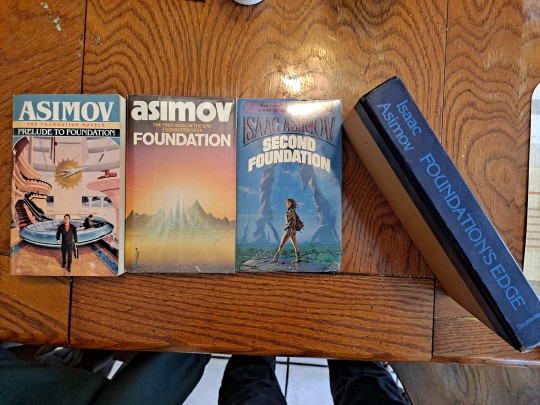
Prelude: a cracked-binding October 1991 Bantam reissue, with a cheesy cover by Will Cormier of an Edward-Norton-looking Hari Seldon checking into a fabulous pink Trantorian hotel. There is an ad in the middle for a collector's edition of the original Foundation novel with the awesome Michael Whelan cover + a copy of the new and "exclusive" short story Cal (I've read it, it rules, though it's a bit of a clip show). In the back, there is an ad for the upcoming novel Forward the Foundation (the best one but not part of my collection yet), TWO author bios and an adorable author photo. Asimov would die shortly after, in April 1992 :(
Foundation: a 1985 reprint by British publisher Panther Books, with a stunning wraparound cover by Tim White of the Foundation's lonely settlement on Terminus. There is an order form in the back for dozens of classic sci-fi books by multiple authors, with prices marked in pounds. I wonder how this European book crossed the pond to end up at a used book store in California? I'm glad it did, or I never would have heard of Tim White.
Second Foundation: a 1987 12th printing by Del Rey, with the iconic Michael Whelan cover of Arkady Darrel my beloved standing among the ruins of Trantor. This is my favorite cover of them all🥰 There is a long-ish and funny intro by Asimov about this series' complicated publication history, and an ad in the back for the original Foundation trilogy + the first spinoff, Foundation's Edge.
Foundation's Edge: a first-edition 1982 hardback by Doubleday. It is missing the dust jacket, which isn't a huge loss since, according to Google images, it's not that interesting. It does have a funny dedication.

Robots of Dawn: a "Book Club Edition" 1983 hardback by Doubleday. It still has the dust jacket, designed by Kiyoshi Kanai; the cover isn't that special but the jacket does have another great author photo inside. There is also some water damage on the last pages (probably from some Giskard x Daneel fan's tears).
Complete Robot: a "Book Club Edition" 1982 hardback by Doubleday. The wraparound robot-arm dust jacket by Kiyoshi Kanai is simple but cool as hell, and features a great big author photo that fills the whole back cover☺️ There is also a lovely "Last Word" that makes me tear up a bit.

Stars, Like Dust: a 1983 hardback "Book Club Edition" reprint by Doubleday. The dust jacket features nice wraparound art by Joe Bergeron. In the afterword, Asimov apologizes for the outdated science of his fictional lifeless world's atmospheric composition, since the book was first published in 1950. He doesn't apologize here for the stupid US Constitution subplot that his editor forced him to add, though I know from other sources that he really hated that thing.
Gods Themselves: a cracked-binding paperback by Fawcett Crest, with no date given besides the 1972 copyright. The cover art is absolutely fantastic and bananas; I think it depicts the 3 gender roles of the aliens' marriage, and the 2 worlds colliding. The book doesn't credit the artist, but ISFDB online identifies him as Charles Moll. Thanks Charles Moll👏👏👏
#asimov blogging#librarian knightotoc#long post#michael whelan#will cormier#tim white#kiyoshi kanai#joe bergeron#charles moll
33 notes
·
View notes
Text
2021 Reading Log, pt 32

156. PNSO Encyclopedia for Children: The Secrets of Ancient Sea Monsters by Zhao Chuang and Yang Yang. This is probably the least of the three PNSO Secrets of books. The text comes off as awfully judgmental about the swimming capabilities of a number of the marine reptiles covered within, and the inconsistencies in the art are noticeable (a Tylosaurus depicted with clawed flippers on one page, without on another, that sort of thing). A number of the anecdotes in the book were already inaccurate when it was written in 2015 (Elasmosaurus with swan-like necks attacking fish from above, plesiosaurs in general beaching themselves to lay eggs). I do commend the coverage, however. About five placodontids appear in the book, as well as several choristoderes and pistosaurs. And most books aimed at this age set view marine reptiles as a sideshow for the dinosaurs, instead of devoting an entire volume to them.
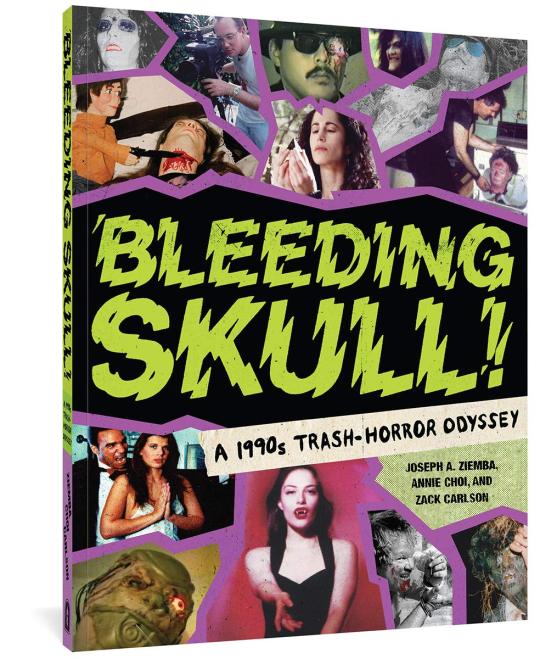
157. Bleeding Skull! A 1990s Trash Horror Odyssey by Joseph A. Ziemba, Annie Choi and Zack Carlson. This book is a collection of reviews about direct-to-video horror movies of the 1990s, almost all of them independently produced and shot on video. There’s a genuine affection for the movies involved—Ziemba is the director of the American Genre Film Archive, and you don’t have that kind of position if you don’t love schlock. It’s basically the book I wanted Analog Nightmares from last year to be: it’s not uncritical of the Z-grade movies on display, but instead can tell the difference between a good viewing experience and a bad one. And I may have developed a parasocial crush on Annie Choi based on her writings found here.
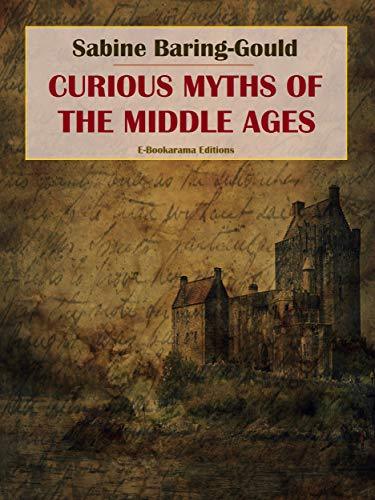
(note: this is not the cover of the edition I read, but that’s a library-bound copy that’s more than a century old. Unsurprisingly, no images of that exact version exist online, and it’s a pretty boring cover besides)
158. Curious Myths of the Middle Ages by Sabine Baring-Gould. The oldest book I’ve read this year, published originally in 1866, in an American edition from 1894. Baring-Gould was a pioneer of folklore studies, and is writing primarily about European myths—Prester John, Pope Joan, William Tell and the like. Baring-Gould has a passion for the idea of the Ur-Myth later espoused by authors like James Frazer in The Golden Bough, and like in that book is a little too eager to assume that the Indian version of all of these Indo-European stories is the “original”. He’s also definitely blinded by his role as an Anglican minister. He accuses basically everyone except Catholics and Anglicans of being idolaters and heretics (in later chapters he is especially huffy about Methodists secretly being holdovers of Druidism), is wildly antisemetic at times, and occasionally views stories as corrupted versions of the Biblical truth. A valuable resource for people interested in European myth and folklore, but not one to be taken uncritically.

159. Around the World in 80 Plants by Jonathan Drori, illustrated by Lucille Clerc. This book is as much about the social history of plants as it is about their biology. The countries the plants are attributed to are ones where the plant has cultural importance rather than necessarily being its origin. For example, castor beans are discussed in Italy in the context of Fascist torture methods, and opium poppies are covered under Australia because Tasmania is a major global supplier. The tone is droll, slightly moralizing, and very British. The illustrations, which to my untrained eye appear to be in pastels and colored pencil, are lovely. The book is worth checking out on their merit alone.
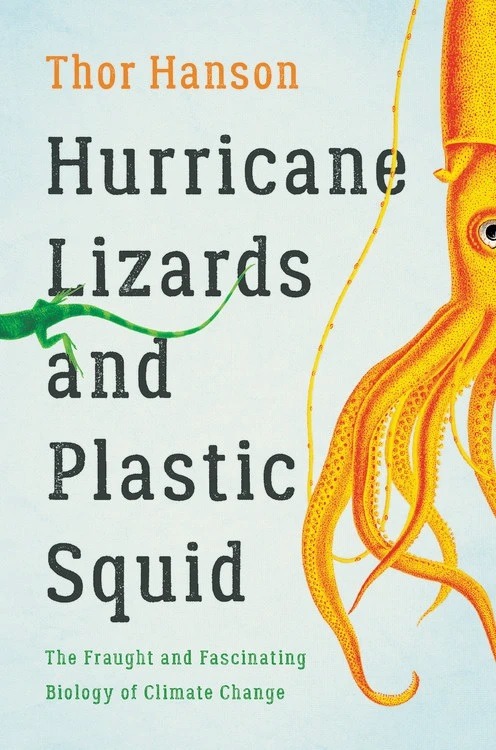
160. Hurricane Lizards and Plastic Squid by Thor Hanson. The subject of the book is how the behavior and evolution of life is changing in response to climate change. Range shifts, behavioral and phenotypic plasticity, and evolutionary adaptations are all covered here. The tone is conversational, and the topics covered flow well together. I like the focus on individual scientists, their research, and the recurring theme of all of these specialists pivoting to climate change studies as the 20th century ended and the 21st century began. What I didn’t like was how the last chapter doubled down on personal responsibility being the primary way to solve the climate crisis. The average person supports green policies! It’s the fossil fuel companies and their inroads into government that are preventing it from happening! Turning off the lights when we leave the room isn’t going to fucking cut it, Thor!
#reading log#medieval folklore#b-movies#climate change#evolution#ecology#botany#marine reptiles#children's books#paleontology#gore tw#sorta
44 notes
·
View notes
Note
Hi! I was wondering if you knew of traditional Greek cross-stitch patterns or even Greek online shops that would either sell kits or patterns? I've been trying to look and found some stuff but they're all from the US. Guessing that the language barrier is keeping me from finding more. Thank you!
Hey there! This was not an easy search even in Greek lmao You would think that something that is very prevalent in Greek traditions would have a stronger presence on the Internet. Please keep in mind, Greek themed is different from Greek. Of course, Greek themed is what you can easily find in English as well (i.e a flag, a ship, an olive tree and so on). Most sources here have Greek patterns instead of Greek-themed stereotypical patterns.
Anyway, I found a few online shops, most of them exclusively in Greek, but first I would recommend to search in Pinterest in Greek if you have an account.
Copy and search with the following keywords alone or combined:
κέντημα (embroidery)
εργόχειρο (handwork - handmade)
σταυροβελονιά (cross-stitch)
σχέδιο or πατρόν (design / pattern)
κιτ (kit)
μετρητό (for counted pattern kits)
σταμπωτό (for stamped pattern kits)
ελληνικό (greek)
παραδοσιακό (traditional / folk)
Slight changes in these words indicate the plural so they are still what you are looking for.
Now, on to some online shops. Since most of them are in Greek only, I am not sure they will send products to other countries but you never know. They have also telephone numbers and emails to communicate with them.
Το αδράχτι
I have already linked the embroidery section. The page you are interested looks like this

Where the baby photo is, there is a number for phone orders. If you choose anything from here, make sure you choose one with a description saying (υλικά για να το κεντήσετε / ξεκινήσετε). It means it provides what you need to make it. The third one is from the collection of Vergina, Byzantine style. There are more Byzantine ones available. It even has Greek Orthodox ecclesiastical patterns.
Ράβω Πλέκω

There are several ways to get in touch with them. They offer patterns Greek or European that are popular in Greek decorations. They have patterns from several companies. I know for sure that the Regina one is Greek, based in Thessaloniki city. I mean, you could also directly communicate with them I guess.
The Knitting Club
This one has an English version too, beyond hope. The HUGE drawback is that these are just simple generic designs for kids. I don't think it's what you're looking for, but well I'm leaving it here since I found it.
ΣΩΤΗΡΙΟΥ
This one for some weird reason has an option for only half-English... whatever. It has many nice options though. Go to HANDICRAFTS, then Κέντημα and then you'll see this, where I have underlined everything that could interest you.
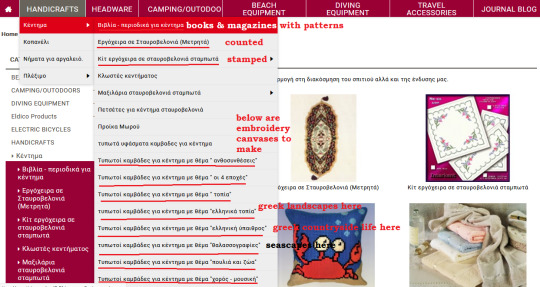
Περί Βελόνας & Κλωστής
Again, I have already linked the embroidery section. I have also underlined all that interests you from the subcategories.

And finally what I think is the safest choice which is books with patterns / designs, because it is cheaper and it provides many Greek patterns all at once from which you can choose.
Αλέξια
A very sufficient variety of books for embroidery and even ecclesiastical embroidery, kids patterns and canvases. Check out all their options. It has their phone and an email communication form on the site.
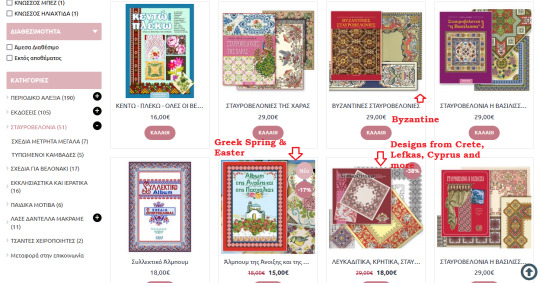
These were the best I could find. They might need you to directly communicate with the sellers though or send them an email and ensure they send abroad.
After all, I don't know if I helped with Greek embroidery but at least you learned some Greek words today hehehe
#greece#europe#embroidery#cross stitch#culture#greek culture#anon#ask#mail#tradition#design#patterns
61 notes
·
View notes
Text
The Life and Times of Scrooge McDuck: The Last of the Clan McDuck! Review “It Was Worth THE Dime”
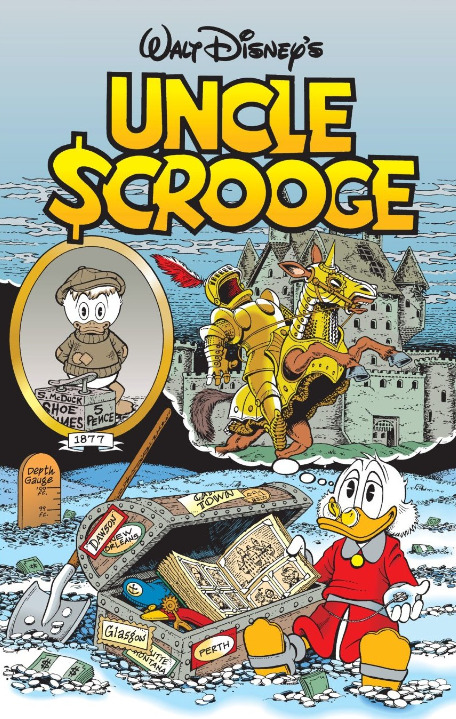
This is one of my faviorite comic book stories of all time. Given i’m a massive comics nerd, for both books and strips, that is the highest praise I can give this wonderful, epic, beautifully drawn and deeply emotoinal story. I first discovered it in the local library that had the second volume, and found the rest online at a now long dead fan site. And while it took me longer than I care to admit to really dig into Duck Comics, and even now i’ve only scratched the surface, I can say without a doubt this story is the reason I’m so deeply attached to Scrooge as a character, and that I was excited as I was for Ducktales 2017. This comic showed me just what Scrooge McDuck should be at his core as a character, and showed me what a wonderful character that is. So with all that glowing praise as you can guess i’ve been wanting to cover this for years, and even considered though back when I was more primarily a comic book reviewer last year. Any time i’ve reviewed stuff before now, i’ve considered it, and with Scrooge’s Sisters Hortense and Matilda presumably and definitely debuting on Ducktales soon, and it’s about damn time, the timing could not be better or clearer to dig into this utter triumph. But before we can take a look at the story itself we naturally have to take a look at the man behind it: Writer and Artist Don Rosa. Don Rosa is easily one of the best Duck Comics writer out there, seen by many as only second to his own faviorite duck comics writer and God of Ducks, Carl Barks. For those 1 of you who do not know, Barks was the man who created pretty much everything in the duck universe comics wise and a bit in animation too: He created Daisy, Scrooge, Gladstone, Magica, The Beagle Boys, The Junior Woodchucks, Gyro, Little Bulb, Glomgold, Rockerduck, and the list goes on. While he didn’t make EVERY duck, he made so many that it’d be impossible to imagine either version of Ducktales being possible without him. So of course Rosa was a fan and while he took up the family buisness, he was also an artist and duck comics fanboy on the side. So when, even if it meant a paycut, the opportunity to actually write and draw them came up, he lept at it and thus became one of their publishers go to guys, even if said publisher published the stories overseas where the Duck Comics are far more popular and still going to this day, and ironically where most duck comics printed nowadays get their stories from. Rosa was known for his meticous historical research and gorgeous art that he took his time drawing to get just perfect and showed on the page. The man has easily some of hte best and most detailed duck art around and I still haven’t found a duck artist that can match him.. and if you have or found one close i’d genuinely love to see that. He is a genuinely talented, spirited guy who was sadly mistreated by disney and that, coupled with tragically failing eyesight, eventually ended his career. He’s still around and I genuinely hope to meet him some day as he still does conventions. The man is not without fault: I don’t get his hatred of superhero comics, as while I get them overshadowing funnybooks and that around the time of his career they were in decline, but it’s just as unfair to write off Superhero comics as mindless. garbage as it is for people to write off the Duck Comics as “only for kids” and I genuinely wish he’d see that and see how the medium has evolved so much since then. I also grumble a bit as his refusal to allow anything besides barks into his bubble, and having to be forced to include fethry on the family tree, but that’s more personal preference. I like using as much material as you got. IT’s why i’ve wanted to, and hopefully will eventually get around to, write a sonic fanfic using bits of all the various universes that for legal, ken penders being an absolute waste of a human being, and sega being stupid reasons can’t be used anymore. I like taking everything in a franchise and putting it in a blender and it’s why I love the reboot. But there’s nothing wrong with taking things as is, not stepping on toes canon wise, but still being awesome. We’re just diffrent people and that’s okay. And a lot of his fanboy showing actually lead to REALLY good things: Goldie O’Gilt was a one off character, and while used ocasoinally overseas, didn’t really pick up as a character again until a combination of Ducktales 87 and Rosa’s work with her, as he always loved the character, and fleshing her out lead to her being used more, and gaining a sizeable fandom. He also gained the Cablleros an even bigger fandom by giving them two stories of their own, and fleshing them out a bit more. And this very comic is the peak of that, taking EVERY mention of scrooge’s past from various backstories to set up adventures, every tiny scrap, and to his credit going to both Barks Himself and various other Barks Experts Rosa was friends with to check his work, especially difficult given he likey had to find these stories in issue or pullt hem from disney archives, and complied it into one long epic that not only uses all this info effortlessly, but spins a compelling story that gives us a clear vision of what Scrooge should be, how he became the man he is, and how he lost himself only to find himself again with the help of three precocious boys and a cynical 30 something duck. So taint all bad is what i’m saying. As for how this got started, thankfully rosa himself provided the origin story for this project in the back of the volume of his works that contained the first 7 chapters of life and times, as well as detailed notes for every chapter. At the time Rosa was working for Egmont, the big european publisher who handles Disney’s much larger european comics market, hence why most of his stories appeared years earlier in Europe before debuting here. The american publisher at the time , and an old friend of his, called Rosa with an idea: A 12 issue Maxi-Series focusing on Scrooge’s history, since at the time they were all the rage.. and really even today mini series are still a viable market and many indie titles just have several minis instead of an ongoing. So it wasn’t a bad idea, Rosa just simply offered a tweak: He’d tell his publisher at Egmont about the idea, and let her get a crack team of writers and artists to do this proper, and thus Disney could publish it for free once it was done and for no extra cost. Rosa gave his publisher a fax detaling both the idea and the fact that it needed to be done right, given to the best person possible, and done with the greatest care. She agreed.. and naturally handed it to him, as he admits he hoped. She made the right call, a legend was born and here we are. One last bit before the read more and before I get to the first story itself at last: Since barks wrote a lot of side stories that fit into the canon, I COULD slot them in between chapters, but have instead chosen to review the original 12 part story as was, and do the various side stories and two epilogues, the utterly fantastic “Dream of a Life Time”, easiliy one of my faviorite comics ever, and the also really great “Letter From Home”, which will likely on some level be the basis for the upcoming at the time of this review “Battle for Castle McDuck!”, after completing the story. In other words i’m probably going to be at this for years. so join me under the read more won’t you as I begin the journey of a thousand miles with a single step as we look at the humble start of a legend.
We begin, after a fun short teaser with present Day scrooge saying his past is no one’s buisness only to get hit with an oh yeah?, with a scrap book title for the issue, something I want to bring up since while I got that’s what it was what I never got, and must’ve glanced over when I first read rosa’s notes when I got this copy, was that it isn’t SCROOGE’S scrap book, but his sister Matilda’s who dutifully and happily catologued her brother’s adventures. It’s a really sweet moment.. and something that will hit VERY hard when we reach Chapter 11. If you haven’t read this story or heard of it.. .that’s this story’s equilvent of “Last Crash of the Sunchaser” and clearly Frank and Matt drew from that story a bit for it, but we can get more into the parallels when we get there. A smaller but fun note is that Rosa had specific coin drawing templates, for different indentions and what not he used, and used them for the coins in these intro bits. Yes he admitted he has a problem and yes that’s damn impressive anyway.
It’s Scrooge’s 10th birthday, and his father Fergus has taken him up to see the family land, Dismal Downs to tell him of the mighty Clan McDuck and show him the ancestral lands, graveyards and Castle. He admits to having taken this long because the Clan McDuck currently lives in Glasgow so it’s kind of a long trip just to show your son “Hey look at the decay and rot that’s our ancestral homeland”. The Clan is on hard times, as a bad shipping deal, the backbone of a rather good barks story and I wont’ be interjecting for every barks reference as it’d get rather tiring though for what it’s worth Rosa provided tons of detailed footnotes in the back of each Fantagraphics collection, so good on him. Speaking of which though they do include 10 pages of Mc Duck family history that was supposed to open this story.. until Rosa’s editor wisely pointed out the story isn’t about them but scrooge and having read his roug draft, yeah.. there’s a good gag here and there, as well as “Dirty” Dingus McDuck, scrooge’s Grandpa and the reason Dewey is cursed with that middle name. Why anyone thought Dingus was a good name is beyond me, nor why Donald thought that was a good middle name back in 2009 is again, beyond me. Good on Don though for getting that past the censors. But yeah with no money they can’t buy the land back and they were scared off it years ago by a mystical ghost dog, the hound of the whiskervilles. There is treasure in the castle, Sir Quackly’s gold, but he accidently sealed himself into a wall while sealing his treasure in there. Their interrupted by the town assholes, the Whiskervilles who have been grazing sheep on the land and are naturally behind the hound, using the sound of it to scare off Fergus once they realize he’s a McDuck. Because apparently you can keep a Scooby Doo style hoax up for Centuries if you don’t have meddling kids around. Who knew. Back in Glasgow, we meet the rest of Scrooge’s family: His Uncle Jake, his sisters Matilda and Hortense, and his mother Downy. Jake hasn’t really been mentioned at all in Ducktales and I know next to nothing about him, which given I share a name with the guy you’d THINK I would. I mean I know a decent amount about this Jake.

But nothing about who the hell Jake McDuck is or why he lives with his brother and his family. Here, you guys watch the dancing Jake, i’m going to probably do that for hours after this review is done, i’m going to go sort this out. Okay one google and finding the Scrooge Mcduck wiki page on him, Jake shows up here likely because he was referenced in the story “A Christmas For Shacktown” and apparently borrowed from Scrooge and never paid it back. Otherwise.. there’s not a lot about him and unlike the rest of Scrooge’s family he really dosen’t do much that I can remember. Except like 2017 Scrooge, he apparently has become extremely long lived, as Scrooge and Donald STILL think he’s alive in the 1950′s.. and likely is STILL alive in some form in the Don Rosa stories, given his take place after Barks and thus in the 40′s and 50′s where Barks stories were set. Hence why unlike the Reboot, Scrooge isn’t inexpecilbly over 210. But Jake McDuck sure as heck is. Maybe this highlander is a highlander.. you know the movie and tv show type. Maybe someone cut off his head. That’s what i’m going with.
This does bring me to another point about this story: While Barks gave all of scrooge’s family their names, it’s where Rosa got them after all, it’s Rosa who really made them into characters. Fergus as a loving father ashamed his family legacy has fallen and wanting his son to do better than him, Downy as an equally loving wife and mother, Matilda as his sweet and caring sister and later her brother’s moral center, and Hortense.. well here she’s just a babbling baby but her character will become clear and glorious as we go. She is adorable here though and we do get some great bits with her. Getting back to the plot now i’ve made my points, Jake is riled up wanting to understandably kick the Whiskerville’s asses with Scrooge, who even as a sweet innocent ten year old still has the family temper already, agreeing.. but Downy gently shoots them out pointing that two middle aged-ish men and a 10-year old just aren’t enough to fight an army of them and while she doesn’t mention it the fight would just tire them out for work and accomplish nothing as while it is the McDuck’s land the combination of the hound and the lack of money to move back means it’s pointless. She also mentions their younger brother Pothole, who went to America. This will be important later.
Scrooge storms off and Fergus laments, in a scene that’s more painful the more I think about it, how his clan has fallen, with he and his brother lamenting their chances at glory are long gone.. but Fergus has hope his son can do better, and for his son’s birthday makes him a shoeshine kit in the hopes of inspiring him to greatness. This scene still resonates since many of us are poor, struggling and not doing so good money wise. I’m sure many parents have doubts and regrets about not being able to do more for their kid.
Not only that but the story carefully avoids the trap of Fergus accidently being abusive by you know, pinning his family’s future on one 10 year old. While yes he is asking a lot of Scrooge, to restore their family name.. it’s very clear he mostly just wants his son to do better than him. Even if Scrooge was just slightly more successful, Fergus would likely be happy with that. He’s not using the legacy as a “This what you must be” like say the Gems in steven universe did for Steven with Rose’s Legacy, the kind where it sort of suffocates you till youc an make it your own. He’s just saying “this is what you can be” He believes his child can be great and simply once him to reach his full potetial and is simply giving him a means to hopefully do so, a simple home made shoe shine kit. While Jake scoffs, the narration notes the idea isn’t worth a dime.. it’s worth THE dime. The dime that would set Scrooge’s destiny in motion.
The next morning, Fergus goes to check up on his son and his new buisness but Scroogey’s having no luck and about ready to just quit, the poor child. Also Matilda is dragging her baby sister around like a doll and it’s entirely precious as it is funny.

But as for those Dorty Boots, Matilda wonders why her dad dosen’t just tell Scrooge that Burt the Ditch Digger is coming. Fergus tells her to quite and then explains his plan: he’s sending Burt to scrooge, with an American dime Fergus and Matilda found, to teach his son a lesson: By giving him a hard days work, he’ll teach him what hard work truly means.. and by having Burt “cheat” him with the American dime, it’ll give him the motivation to keep going and to nto be as wide eyed and trusting. It’s a well meaning if harsh lesson, and the kind you’d expect from 1900′s parenting and fits the origin well: Scrooge still earned his first money square, as he still did work.. but his getting cheated being a lesson dosen’t diminish what it taught scrooge, and helps flesh out what I talked about above, Fergus knowing his son has great potential he just needs inspiration to reach it. And instead of just telling him that he does a con job but it’s the 1900′s. This orign, and Fergus’ part in it would be entirely untouched in Ducktales 2017, the first scrooge based adaptation since this comic came out, and I bless them for it. Frank even said this comic was used as a bible by the writers and while theirs clear deviations, and we’ll get to that, they were mainly done for good reason, and it’s very clear that while scrooge’s history is very VERY diffrent in the reboot, the core of his past is still there.
So the plan is on and young scrooge spends half an hour killing himself to get Burt’s shoes clean before getting his dime.. and realizing he’s been had, makes this proud decleration that will be the bedrock of his entire life and character.
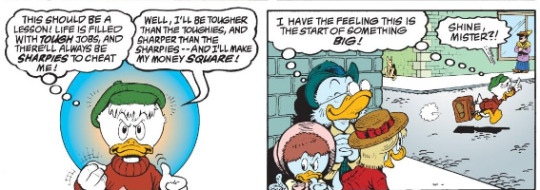
Scrooge being naturally stubborn as you can see takes his cheats a leson: There will always be hard honest work, and he will be there to do it and he’ll be tougher and sharper than anyone trying to cheat him out of his pay. Fergus’ plan has the intended effect, and Scrooge having learned a hard lesson now has the drive and determination we know him for. As for why it gives it to him.. I had to think on it a bit but it makes sense: For some a setback like this would make them quit.. for Scrooge it’s just proof he CAN find customers, he CAN do this job, or any at his hardest and instead takes this as a lesson to be prepared ot out think and outfight anyone who dares cheat him again, and to not earn his money by being the kind of guy who cheats a kid out of an honest days pay, but as a good honest duck like his father and his father before him. =He will make his money square so he can be the kind of person this seeming stranger SHOULD have been. Granted we’ll see Scrooge doesn’t end up as the best person at times but .. we’ll get there. So with the fire inside turned from a spark into the flame Scrooge soon got to work, and by the next panel we see he’s eventually worked his stand up from a small box given to him by his dad, to a three seater shoeshining bench, who he wipes all at once by stretching one of his mother’s girldes over a light pole, a detail I didn’t get the first time around but now love. Naturally being a good kind boy much like his Nephews, Scrooge always gave his proud father a portion of his earnings, if with a full receipt for tax purposes. Because he’s still scrooge after all. His dad wonders he did too good a job while Hortense glxbit’s in agreement.
As the years go on, a now tween Scrooge is eventually able to save up for a horse cart, and starts selling Fire Wood up in the city. He eventually realizes Peat, an earthy subtance found in bogs I only know about because I had to look it up for this review, is more profitable and with some snappy marketing moves into selling Peat for the rich instead, also showing the young lad already has a grasp of how to sell to obnoxious rich people.
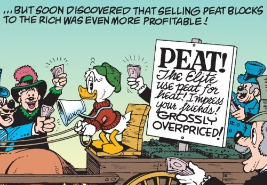
But while his business is booming, our young hero can’t resist visiting his family’s ancestral home and longing for it, hoping one day to have it for himself and in a nice show of how despite his temper and tenacity forged over the last few years he’s still at hear the kind, sweet optimistic lad he was just a few pages ago, he decides to tidy up the Clan’s Cemetary while he’s here.
Unfortunately as proof that Donald and Della’s terrible luck comes from both sides of the family the Whiskervilles are sub-glomgold levels of human beings.. or Dogfaces in this case, and are digging up the McDuck Clan’s graves to hunt for treasure. Scrooge tries to simply do the smart thing and flee, but the asshole brigade catch sight of him and mistkaing him for a peat burgalar chase after him.. and spend WAY too much time and energy chasing a teenage boy over some fucking bog grass you clearly aren’t selling yourselves. I mean spare a thought for how dumb this is: They could easily sell of of that peat to put up a fence or chop down some trees to get the material if their really that concerned about someone getting in the bog. Then again this isn the 1800 and 1900′s where the child death toll was simply “Yes”, so they likely thought whose gonna notice one more dead child on our property?
Scrooge heads toward the castle and is gestured in by a friendly mystery duck who gladly shows him around and can tell he’s a McDuck just by look, showing the castle is still in glorious condition as the whiskervilles are too spooked to go in, hence why they didn’t chase Scrooge inside. I’d say being afraid of ghosts but not murdering a child is weird but these are the same guys who thought murdering a child was plan A. We’re not dealing with a brain trust is what i’m saying. So the mystery duck shows Scroogey around, showing off some colorful stories about his ancestors recycled from that scrapped prologue I mentioned. THe mystery man, who brushes off Scrooge thinking he’s a McDuck asks Scrooge what he’s doing to restore the family glory and while Scrooge points out he’s already working on it, Mystery Duck points out he’s still missing something: He has the drive and the dream, but peat and shoeshining, while getting him good money for his family, aren’t the thing you can build a fortune or a future off of. He then points out where Scrooge’s dime comes from: America.. and that gives the boy the idea to head to the states. As for what he could possibly DO there to start, the mystery guy mentions his uncle pothole. So Scrooge has the dream, the drive.. and now a plan: Go to america, work for his uncle on the riverboats, and work his way up from there till he finds his fortune and restores his family name. But while his future is settled, the present is still an issue and Scrooge wants to teach the child murder club a lesson and thus borrows, though MM wisely points out it’s all his property a horse and some armor, and stuffs the armor with peat. As for what his plan is.. welllll
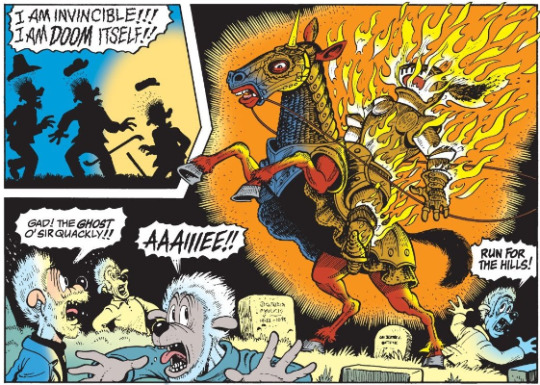
That.. is fucking awesome. And far from the last fucking awesome moment in this thing. It also shows off even as not quite a teen yet, Scrooge is still a badass already, and while he doesn’t have his trademark strength or fighting skills quite yet, his ingenuity is already there.. and that will always trump both. The Whiskervilles run away and into some quicksand and Scrooge vows to return one day as laird and reclaim his family land. But that’s a story for a few chapters down the line. As for who the mystery duck is, he’s naturally Sir Quackely himself, or rather his ghost, who was simply guiding Scrooge and didn’t give him the treasure as simply handing him the money wouldnn’t restore their family’s good name or continue their bloodline now would it?
For now Scrooge returns to work for a bit before finding his way to America: A cattleboat to New Orleans looking for a Cabin Boy. And so Scrooge bids farewell to his family. His Dad, feeling bad he can’t even give his boy shilling, gives him the family pocketwatch with jake pitching in with the family gold dentures. While Scrooge naturally refuses to sell the watch, he does plan to sell the teeth as soon as possible for good reason. We then get some sweet goodbyes with him, his sisters (With hortense uttering her first words to everyone’s astonishment) and loving mother as he wonders just what awaits him in America.
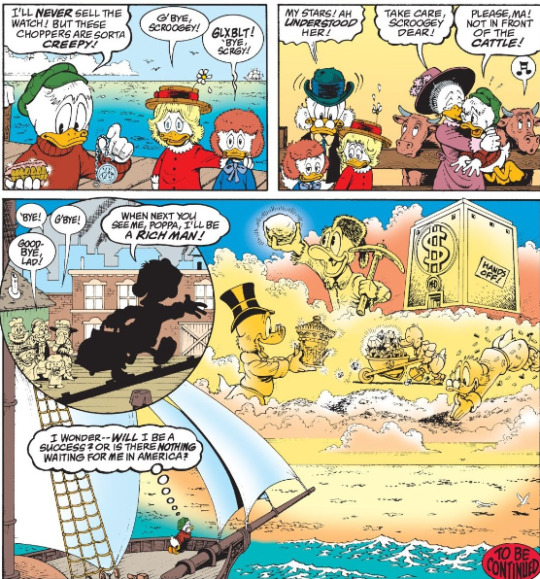
And there he stands on the bow of a ship, heading for a new land, in New Orleans he can be a new man. And we’ll see just what kind of man he becomes as this series continues. For now this is the end of a chapter but the beginning of a lifetime.
Final Thoughts on Last of the Clan McDuck:
This story is excellent. While there are even better chapters to come, this one is still one of the most memorable and most joyous, showing just how Scrooge became what he is, where some of his values come from, others will be instilled along the way , and beginning to flesh out his family. We see Scrooge’s love of wealth comes from starting from the bottom, growing up with a family that barely had anything and badly needed everything, but was loving and instilled fine morals in him. We also see a Scrooge far removed from the bitter old man he is in present day, an optimistic naïve young lad who only wants best for his family. It’s a nice stark contrast to who he’ll become, good and bad, and a nice way to both compare him to Huey Dewey and Louie and break your heart as his own hardens before briefly turning black later on. The art, as is standard for this series and Rosa, is breathtaking, and the story isn’t lacking in good jokes, their just downplayed so the story itself can take center stage. There’s nothing really more to say: it’s an excellent start to an even more excellent tale and stands proud among an already stellar story as one of it’s finest outings.
NEXT RAINBOW: Scrooge goes down to the mighty Missipi to work on the riverboats and meets one of his signature Rogue’s for the first time in their first form, as well as Gyro’s dad.. or grandpa.. or possibly both I don’t know his family tree. Point is, tune in next time for some riverboat hyjinks. Until then if you’d like to comission an episode of any animated show, especially ducktales and the various other duck related disney shows, or another Duck Comics story you really like from Rosa, Barks or whoever you want really, I take commissions for 5 dollars a review, with 5 dollars off your full order when you put in for more than one episode or issue. You can also follow me on patreon.com/popculturebuffet and for just two bucks a month get access to polls (which i’ll start once we have at least three patreons), and my exclusive discord server. And if you liked this review be sure to reblog it to show off. My self promotion done until next time: There’s always another rainbow.
#scrooge mcduck#don rosa#ducktales#the life and times of scrooge mcduck#fergus mcduck#downy mcduck#hortense mcduck#hortense duck#matilda mcduck#jake mcduck#uncle scrooge#duck comics#disney duck comics#carl barks
60 notes
·
View notes
Text
Happy Anniversary “Meteora”! (March 25, 2003)❤️

Meteora is the second studio album by American rock band Linkin Park. It was released on March 25, 2003 through Warner Bros. Records, following Reanimation, a collaboration album which featured remixes of songs included on their 2000 debut studio album Hybrid Theory. The album was produced by the band alongside Don Gilmore. The title Meteora is taken from the Greek Orthodox monasteries sharing the same name. Meteora has a similar sound to Hybrid Theory, as described by critics, and the album took almost a year to be recorded. It is the first Linkin Park studio album to feature Dave Farrell after he rejoined the band in 2000.
Meteora debuted at number one on the Billboard 200, selling over 810,000 copies in its first week. Linkin Park released singles from Meteora for over a year, including "Somewhere I Belong", "Faint", "Numb", "From the Inside", and "Breaking the Habit". The song "Lying from You" was released as a promotional single. Meteora received generally positive reviews, although critics noted that the album's musical style was similar to its predecessor Hybrid Theory .
Meteora has sold over 27 million copies worldwide, making it one of the best-selling albums of all time. It is certified 7x Platinum by the Recording Industry Association of America (RIAA). It was ranked number 36 on the Billboard Top 200 Albums of the 2000s. Some songs from the album were remixed with some of Jay-Z's songs for the EP Collision Course (2004). "Session" was nominated for Best Rock Instrumental Performance at the 46th Grammy Awards.
Initial writing for a second album dated back to early 2001, while still touring in support of Hybrid Theory. The band had written around eighty different demos during their Hybrid Theory World Tour and LP Underground Tour, within the span of just eight months. Rough song ideas written then would find its way to the final album; notably the intro for "Somewhere I Belong". Bennington recorded guitar notes for it, but found it too folk rock sounding. However, Shinoda and Joe Hahn reworked it, adding effects to it, and then played it backwards, molding it into something the band was happy with. As explained by Shinoda: "Since I reversed it, it was playing 4-3-2-1. The chord progression was reversed. Then I cut it into four pieces, and I played it 1-2-3-4. And that's why it has that sweeping sound.
In early 2002, after the touring, the writing continued in Mike's home studio, pre-production of the album began there. The band worked in pairs during the writing process, whereas Shinoda was always involved in all the songs. The recording of the songs mainly used Pro Tools, whereas the band used the traditional method of writing, in main studio. In June, pre-production terminated and the band headed for main production. The band finalized Don Gilmore as their producer. When Reanimation was released, the band had started to write the main content. Rob Bourdon spent eight hours a day in the studio for the recording of the album. By August, the band entered NRG Studios as Bennington also began writing songs with the band.
Linkin Park had finished versions of many songs before the actual recording process had begun, but they majorly wrote the finalized songs included in the track list in the studio. By October the drums were finalized and guitar parts were introduced by Brad in the control room of the studio. By the end of October, the bass parts were introduced. Don Gilmore himself being a bass player helped Farrell in his recording. The sampling part by Hahn was introduced just a month before the deadline, thereby Mike finished the recording of "Breaking the Habit" with strings arrangement by David Campbell; the song had been worked on by Shinoda for five or six years. The vocal production started in November. The mixing process as well as the album itself was finished in New York City.
Lyrically the album contains elements including depressing emotions, anger, and recovery. Explaining to MTV, Bennington said: "We don't talk about situations, we talk about the emotions behind the situations. Mike and I are two different people, so we can't sing about the same things, but we both know about frustration and anger and loneliness and love and happiness, and we can relate on that level." In the same interview, Shinoda explained it as: "What we really wanted to do was just push ourselves and push each other to really find new ways to be creative." He continued: "We wanted each sample that was in each song to be something that might perk your ear – something that you might not have ever heard before." In a promotional interview, Rob Bourdon stated: "We wanted a group of songs that would sit well together because we wanted to make a record that you could pop into your CD player and, from beginning to end, there would never be a spot where you start daydreaming." In titling the album, Mike said that "Meteora was a word that caught my attention because it sounded huge." Dave, Joe, and Chester elaborated that just like how Meteora, the rock formations in Greece, is very epic, dramatic, and has great energy, the band wanted the album to have that same feeling.
Genre-wise, the album is categorized as nu metal, rap metal, rap rock, and alternative rock.
The promotion for the album began well ahead before its release, as pictures of the band recording were distributed to the media. To support the album, there were many photo shoots of the band on October 29 at the Ambassador Hotel, where the band took a break from recording the album for two days, for designing the cover art of the album. "The Flem" and "Delta" helped the band for the art works, for the album as well as for the singles spawned by it. A TV commercial for the album was premiered on January 1, 2003. "Somewhere I Belong" was released as the first single, premiering on US radio on March 18, 2003. Being released only nine days before the album release, it influenced the album sales performance worldwide. The second single off the album was "Faint", released before the band started its world tour. The third single "Numb" was released when Linkin Park performed it live in Madrid. "From the Inside" was released as the fourth single off the album before the North American leg of the world tour. "Breaking the Habit" was released while the band was in Indonesia. The album was released with various limited edition content for promotional purposes.
There is a special edition of Meteora, which includes the "Making of Meteora" DVD documentary. The special-edition package was packaged in a blue tinted case with the blue Meteora cover that can be found in some parts of Asia, United States, and more commonly in India. An alternate Indian version contains an alternate DVD and alternative cover that is packaged in a slimline case with the disc in original packaging. The "Tour Edition" of Meteora is packaged in a two disc set. The second disc, which is a Video CD, has the music videos for "Somewhere I Belong", "Faint", "Numb", and "Breaking the Habit". The tour edition is packaged in a standard Compact Disc case, rather than their trademark digipak case. The album was also released on a very limited quantity of vinyl records (spread across two LPs) under Warner Brothers. These are coveted by collectors and fetch high prices at auction. In 2014, Linkin Park released a demo version of Shinoda singing the song, on their 14th annual fan club CD, LPU XIV.
The band promoted the album with their Meteora World Tour and various other supporting tours. The world tour was supported by Hoobastank, P.O.D. and Story of the Year. The band played shows at Pellissier Building and Wiltern Theatre on the day before the album release and on the release date. The shows were called "'Meteora' Release Show". The European leg was cancelled because Chester was having severe back and abdominal pains. As a result, half of the music video of "Numb" was shot in Los Angeles and the Czech Republic. The album was also promoted by the Projekt Revolution festival. A live album was released in support of the album titled Live in Texas. Linkin Park played various special shows worldwide, including "Reading Ireland", as well as performing during the Kerrang! Awards, "Livid", "X-103's Not So Silent Night", "The End's Deck The Hall Ball" and "KROQ Almost Acoustic X-Mas", in promotion of the album.
Meteora received generally positive reviews, although critics noted that the album's musical style was similar to its predecessor, Hybrid Theory (2000). The overall Metacritic score is 62. E! Online rated it A, and expected it to "shoot straight for the stars". Entertainment Weekly described it as "radio-friendly perfection". Dot Music described it as a "guaranteed source of ubiquitous radio hits". Rolling Stone said the band "squeezed the last remaining life out of this nearly extinct formula". Billboard Magazine described Meteora as "a ready-made crowdpleaser". The New Musical Express said it had "massive commercial appeal" but left the reviewer "underwhelmed".
AllMusic described the album as "nothing more and nothing less than a Hybrid Theory part 2.", but added that the band "has discipline and editing skills, keeping this record at a tight 36 minutes and 41 seconds, a move that makes it considerably more listenable than its peers... since they know where to focus their energy, something that many nu-metal bands simply do not." Sputnikmusic writer Damrod criticized the album as being too similar to Hybrid Theory, but praised the album's production quality and catchiness, stating "the songs just invade your brain".
Blender described it as "harder, denser, uglier", while Q described it as "less an artistic endeavor than an exercise in target marketing." Entertainment Weekly gave the album a B+, calling it a "thunderously hooky album that seamlessly blends the group's disparate sonic elements into radio-friendly perfection".
The song "Session" was nominated for a Grammy Award for Best Rock Instrumental Performance in 2004.
In its first week, Meteora debuted at number one on the Billboard 200. The album sold at least 810,000 copies its first week of release. As of June 2014, the album has sold 6.2 million copies in the US, and over 27 million copies worldwide. The album was ranked number 36 on Billboard's Hot 200 Albums of the Decade.






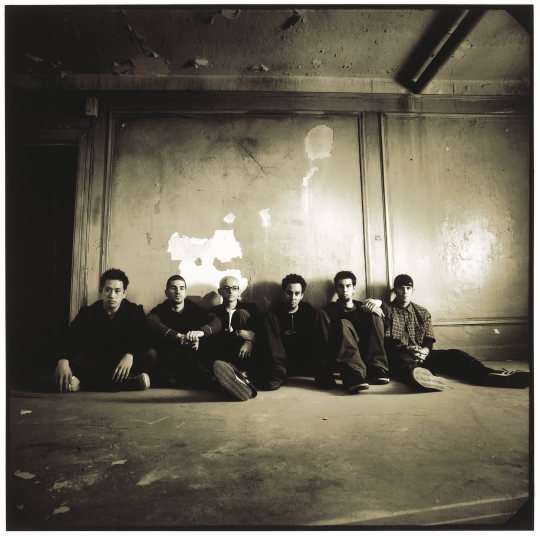


#linkin park#meteora#march 25#march 25th#3.25#3.25.03#3.25.2003#march 25 2003#march 25th 2003#2003#mike shinoda#brad delson#rob bourdon#joe hahn#dave phoenix farrell#chester bennington#2000s
10 notes
·
View notes
Text
Language Learning, Mom’s Birthday | #43 | August 2020
Since Mom had held language-learning close-to-heart, I dedicate my August update to a language theme!
With August 9, 2020, my late mom turned 55. I’ve often felt since 2017 a bittersweet fondness for the summer months between Mother’s Day and her birthday. That year had been my first summer in China getting to know Mom’s family after her death.
For this August’s story, I’ve reflected a great deal on my experiences with language learning. Of which I’d written before, I’ve basically chosen five languages as the ones I want to be functional using (my native English included). So beyond the usual reflections from this COVID-19 summer in the States, I also take us back through my young life learning.
And, I’m pleased to announce that I've begun to work on a new writing project! More on that soon.
From Multilingual Mom to Me
I start us from spring 2020, around evacuation back to the U.S. from Peace Corps Mongolia.
By April 10-16, I’d been in my sixth week in Vegas again. Yet, less than a couple months before, I was in Mongolia packing to evacuate. As part of my coping while packing, I’d listened to hours of music. Much included Chinese Disney themes I’d found on Spotify.
Well, having returned to Vegas, you might recall that the sisters’ songs in “Frozen II” resonated deeply with me. Whether while waking or working the yard, I’d listen to “Frozen II”' tracks in Chinese, sometimes in English. Finding songs in other langauges fit my 2020 exploration resolution. I humorously suspected that my Spotify Wrapped 2020 will surely list the same tracks in different languages... if only Spotify had Mongolian versions. Well, a month later, by week 10 (May 8-14), I’d exchanged the songs’ English versions for Spanish!
That week also featured May 13, 2020—the third anniversary of Mom’s funeral. This year, something special happened.
I’d received a fateful book—A Primer of Ecclesiastical Latin. My college pastor had ordered this for me just days after I’d asked him what I should consider studying while discerning during quarantine a doctorate in religious studies. After my pastor noted my interest in world Christianity, especially its past and present in Asia, he highly recommended I study Church Latin.
My pastor’s suggestion pleased me in a curious way. It reminded me of my Duolingo dabbling back in Mongolia, how at that time I’d favored Latin over Greek. Still, Liturgical Latin, studied seriously, seemed like quite an undertaking. Nonetheless my pastor commended my talents and felt confident I could succeed along paths God may open for me. I felt grateful for the aid!
Embarking on my quest to learn Latin, I’ve found the language remarkable.
It’s felt at times the culmination of my years learning languages. In fact, Mom had actually wanted my siblings and me to learn languages since we were little—She’d taught us to read English then tried to have us learn Chinese. Most summers, she’d have us in the mornings copy down Chinese characters before she’d let us play games or do activities that weren’t “educational.”
While cleaning my family’s garage this COVID-19 this summer, I’d unearthed old notebooks in which my siblings and I would write Mom’s required phrases. I noticed how even back then I’d seem to try harder than most of my siblings, given how many characters I copied. Still, I hadn’t much inclination to know the language words beyond, then, clearing Mom’s barrier to letting me play games.
Still, even if the notebooks had implied some aptitude I’d had for languages, Mom’s requirements left me if anything more averse to language acquisition than eager.
Suffering Through Spanish
Many today may feel surprised to know that for years I’d called Spanish my second language.
Given my childhood disdain for studying languages beyond English, I’d found my task to study Spanish in high school assiduous. I formally began in the language fall 2011 as a freshman. Spanish was our Vegas school’s only foreign language option, and all honors students needed two years of language. Yet again, my language studies drew from a requirement—little more.
Many of my classmates and I rapidly found our classes exhausting, for our instructor had a thick French accent. Furthermore, verb conjugation, unfamiliar tenses and gendered vocabulary felt alien. I didn’t get why a language would be so complicated.
Yet, despite my struggles to understand our teacher, she’d commended me because I “made the effort.” Well, I sometimes felt like I’d make the effort to a fault. When peers cheated on exams, my darn integrity had me abstain.
By my second year, when I was succeeding in college-level AP world history, my fleetingly flawless GPA took from Spanish a beating. That hurt. By my senior year, at least Mom let me take Spanish online instead. I’d learned that I’d known more than I thought, but I still sucked.
Redemption Through Mandarin
By fall 2015, I’d had graduated high school and enrolled as an honors undergrad facing another foreign language requirement.
Licking my wounds from Spanish, I ruled out that language. I saw the University offered Chinese, though. Studying world history had interested me in Mom’s cultural background and native tongue. Considered she’d made my siblings stare at the language since childhood, I hoped it wouldn’t be too hard. So, I chose Mandarin Chinese.
And by my first days learning Chinese, I could already feel the benefits of having taken Spanish.
Chinese felt astoundingly straightforward. Spanish had taught me to recognize that English letters (better known as the Latin alphabet) sound differently in different languages. For example, I felt pleased to notice that the ‘a’ /ah/ letter in Spanish sounds similar to its Chinese pronunciation. Thus, Spanish’s “mamá” and Chinese’s “māmā” relate, despite appearing in separate languages.
Thanks to my Spanish experience, I picked up Chinese’s general pronunciation system far faster. Furthermore, I felt relieved to find that Chinese grammar lacked the conjugation and gender nightmares I’d faced in Spanish. I’d even loved how Chinese characters’ little images could often help me guess word meanings intuitively!
My interest and success with the Chinese language led me to study abroad in 2017, planned with my mother before she was killed. I returned to China a year later, in 2018 on an intensive program. Both times, I spoke my mother’s native tongue, meeting relatives and making friends. I even received awards for my skills.
Yet, despite my progress in Chinese, I’d often considered it only my third language. After all, much of my success in Chinese came having struggled through Spanish.
Finding Peace with Spanish
In my college senior year, January 2019, I’d attended a religious pilgrimage in Panamá—a Spanish-speaking nation.
By that time, I’d grown acquainted with language immersions. In fact, I readily used my Mandarin skills when I met World Youth Day pilgrims from Hong Kong, Malaysia and Taiwan. They often felt shocked to meet someone outside their communities who knew their language!
Of course, Panamá left me at times surrounded too by folks who only spoke Spanish, including my host family.
I listened carefully. A luminous spark, I’d felt. Buried memories of my broken Spanish resurfaced. Near my last day in Panamá, I felt awed to have had a conversation with a cab driver completely in Spanish.
My peace with Spanish became a renewed interest.
After our pilgrimage, I’d continued with my host family and new Latin American friends to speak and write almost exclusively in Spanish. Online, we benefited over WhatsApp with Google Translate, too. Panamá in 2019 had taken a language that was for me dead and breathed in it new life.
Peace Corps Language Level-ups
Later that year (last year), I began to learn what would be my fourth language and one entirely unfamiliar—Mongolian.
I should note that before reaching Mongolia June 1, 2019, I couldn’t even read its Cyrillic alphabet. I’d basically started at zero.
Peace Corps’ language briefings had at least taught me that Mongolian is an Altaic language, distinct from Indo-European language like English and from character-based languages like Mandarin. Over the course of summer in villages of Mongolia, Peace Corps put us through mornings of immersive language training followed by returns home to our host families.
Still, many Peace Corps Trainees felt unmotivated to learn Mongolian. After all, with statistically few Mongolian speakers worldwide, many felt that we wouldn’t have much utility for Mongolian outside Mongolia. Nevertheless, I felt motivated by desires to understand and feel understood. I powered through.
Initially, Mongolian baffled me.
Its Cyrillic alphabet (and its script one, too) includes consonant and vowel sounds unknown to English, Spanish and Chinese. Furthermore, Mongolian uses a case-based grammar of suffixes, a reversed subject-object-verb order and postpositions instead of prepositions. Mongolian even reintroduced me to my nemeses gendered vocabulary and tense-based verb endings!
I felt grateful for the sparse Chinese loanwords I wouldn’t have to relearn! Yet, my kryptonite was often pronunciation. Challenging consonants and tricky long vowels left me so inauthentic. Regardless, I was an ardent study who savored most every chance to receive Mongols’ clarifications and corrections.
Finding Latin in Asia
Curiously, Catholic Churches became great places for my language learning.
This was the case for me both with learning Chinese in China and Mongolian in Mongolia. Parishioners would often take me under their wings to support me. Curiously in Mongolia, an English-speaking French parishioner pointed out once that Mongolian grammar is quite like Latin. I didn’t know Latin, though.
I had encountered Latin, though. For, Asian vocabularies for Church topics often derived more directly from Latin than even English translations! These pleased me, since learning the vocabulary to speak about religion felt less foreign.
Then came the sleepless nights during Mongolia’s COVID-19 preemptive quarantining, January and February. I’d had taken up Duolingo and opted for Greek or Latin in hopes that they’d bore me to sleep. I’d also hoped they might supplement how I teach English and read Scripture. And while Greek felt hopelessly confounding, Latin vocabulary felt surprisingly... natural. Despite my lack of formal training, I did alright just guessing.
My Roads Led to Latin
From late May through mid-June 2020, I’d read the first four chapters of the Church Latin book. Meanwhile, mid-summer, I felt pleased to reach Duolingo’s Diamond League! Realizing that to become Champion would take far more effort than I cared to give, though I focused just on keeping my streak.
Still, my Latin especially progress slowed after Dad’s remarriage and my relocation to Reno, Nev. My mostly-free summer rapidly grew hectic. But even in those first four Latin weeks, I’d discovered true gems in pursuing the historic language.
At face value, Latin’s vocabulary reminded me of Spanish and English. Sometimes, Church words I’d learned first in Mandarin and Mongolian too related! Vocabulary felt profound.
Furthermore, Latin grammar felt reminiscent of not only Spanish conjugations but indeed Mongolian cases! I felt relieved that Panamá had freed me from my conjugation aversion. Likewise, my Mongolian skills felt far from obsolete!
To supplement my Latin studies, I try to translate between Chinese and Spanish, the way how in Mongolia I’d translate between Mongolian and Chinese. By juggling languages, I seek to codeswitch in more contexts with a more unified vocabulary.
Wherever I wind up academically and professionally, I hope to work between languages. Through daily discipline, textbooks, apps, videos, notes and conversations, I trust I’ll go far. Feel free to connect if you want to practice with me! The more corrections, the better.
From Ecclesiastical to Classical Latin
On August 23 (of my stateside week 25), I’d reunited in Vegas with a high school friend who’d studied classics in undergrad. From that meeting on, I’d not only ramped up my Latin studies but also transitioned from Ecclesiastical Latin to classical.
For, Church Latin is but an evolving Latin. To understand the orgins of many words—beyond simply their uses within the Roman Catholic Church—I would need the eternal Latin that changes no more. Well, my friend offered to tutor me, so I offered to try!
Classical Latin is harder, by the way.
And in the midst of my suffering throughout September, my friend had even offered to tutor me Greek. While mostly joking (but also not), I’ve offered that I might learn Greek from him if for no other reason than to thank him for teaching me Latin!
Nearly a month since beginning the tutorial system with him, we’ve since cleared over a fourth of a textbook meant sometimes to take a year’s worth of study. I hope by the year’s end to have finished the book.
At least a third of my waking hours at times seem to go into Latin. But, it’s nice to keep learning! That same week, my siblings had all resumed their undergraduate studies. At least I’m still learning something!
Embarking on a Book Memoir
Besides working on my other languages, I’ve even placed time in my English.
Lastly, I want to share about my writing quest! Although the project isn’t always across the top of my agenda, I keep at it. We return again to mid-summer.
Peace Corps friends and I have often checked in on each other since evacuation to the States. Some also write. During a webinar for evacuated Returned Peace Corps Volunteers, I’d met many looking to tell their stories.
Most weeks since July, I’d also have a few video calls. I’d take these no matter what I was up to. I’d still been doing that ‘groundskeeping’ in Reno, Nev. of which I’d written before. Whether I was getting the mail, trimming the hedges, pruning the flowers, watering the lawn, raking debris, sweeping the floor, taking out the trash, tugging the garbage bins, adjusting the windows or washing the dishes, I’d often had some task that Dad requested I’d tend to. Calls with friends broke the monotony.
After encouragement from mentors and friends, I’d decided to write a creative nonfiction book memoir for publication someday!
The first step, of course, is having a manuscript. So, since week 17 (June 26–July 2), I’d been typing away at the first chapters to what seems will be a story spanning my three years of studies and service overseas after Mother’s death, leading up to my acceptance and peace. I'm excited to tell stories about finding purpose and identity, despite grief and loss. I hope it helps readers to find their own peace amid confusion. All things are so fundamentally interconnected.
By three weeks in, I’d felt so grateful for the outpouring of support I’d received. Frankly, I wouldn’t be writing so much if people hadn’t been saying this has potential. Thankfully, readers offer marvelous insights. They treat the story as one deserving of quality. I love their attention to details.
Still, among the most grueling lessons I’ve learned learned has been that a book about grief has needed me to relive the hurt of my mother's death for repeated days. I trust nonetheless that once I’ve written and rewritten well, the remaining may rest behind me.
If you’re looking to read what’s coming, you’re in the right place. Merely starting on the book has helped me to improve my blog writing. You may have noticed in my recent summer 2019 throwback stories, for example, I’ve used more narrative than before. I hope you’ve enjoyed!
The language studies and the book continue, though I’ve taken more breaks lately with the book. From mid-August I’d embarked on advocacy projects with the National Peace Corps Association. I’ll share more on that soon. Having doubled-down on my Latin studies from mid-September, it can be a quite a black hole for my time! For everything there is a season (Ecc. 3:1).
Seeking to Stay Holy
A couple friends admired my dedication and called upon me to help them meet their spiritual goals. What a kind expereince! In helping them keep accountable, they’ve likewise helped me.
With a homebound Knight of Columbus, we’d continued July’s rosaries throughout August, as many as three times a day leading up to the Catholic Feast of the Assumption. Afterward, we’d reduced our count back to two times daily through early September. I’d never prayed so many rosaries before!
Through August, I’d also read a chapter of Proverbs daily with a friend. I’d reconnected with her during my outreach for the book. I enjoy our weekly Scripture chats, and she shows more Protestant perspectives on our faith!
I find God a great companion along the journey of life. Regardless of how you view religious and spiritual topics, I trust that you have companions, too. They’re so important!
On a positive note, I’d gotten to revisit my undergrad parish. I felt so amazed to hear that students I’d never met thought I was a cool person! I try not to think too highly of myself, but I feel touched when people notice me. I hope I inspire folks.
Coming up Next
Thanks for reading my meta-stories about languages and stories!
If you’ve been following my tales for a while now, you may recall I’d mentioned feeling surprised to learn that my mother had been studying Spanish around the same years I’d been studying it. I felt awed to realize that even when I’d tried to learn one of my earliest new languages, Mom was trying to learn what was for her one of a few. I’m glad to have perhaps inherited Mother’s interest in languages.
Up next, I have a very special piece dated for September 2020 [and ultimately released in October]. I’m focusing on perspectives—mine and others’. I’m particularly excited to share adventures with teams including those within the American Psychological Association and the Honors College at the University of Nevada, Reno. They’ve given me plenty of fun roles amid the pandemic!
I’m also writing about national and state parks! God, I love nature.
Stay healthy, friend.
COVID-19 and America Months 11 through 15 | April, May, June, July, August
Easter Epilogue in America | #35 | April 2020
Remembering Mom—Third Year After | #36 | May 2020
Fathers’ Day, Faith and Familiarity | #38 | June 2020
23rd Birthday~ Roses and Rosaries | #39 | July 2020
Language Learning, Mom’s Birthday | #43 | August 2020
You can read more from me here at DanielLang.me :)
#memorial#WithMe#StayHome#languages#Nevada#Peace Corps#Mongolia#memoir#story#Catholic#God#memoryLang#Disney#Chinese#Mongolian#fall#Latin#evacuation#Coronavirus#COVID-19
1 note
·
View note
Text
15th September 1507: Establishment of Scotland’s First Printing Press

(The devices of Walter Chepman and Androw Myllar, Scotland’s first printers)
On this day 512 years ago, King James IV granted a charter under the privy seal to the partnership of Walter Chepman and Andrew Myllar. This is the earliest record of Scotland’s first known printing press, established around the same time by Chepman and Myllar, in the Southgait of Edinburgh. Although the press was destined to be short-lived, in its brief career it printed several notable books, including poems by Dunbar, Henryson, and Lydgate, and also the Aberdeen Breviary, the Scottish liturgy compiled by William Elphinstone, Bishop of Aberdeen. Several of Chepman and Myllar’s prints have survived (some in very fragmentary states) and constitute an important source for the history of Scottish literary culture.
The king’s charter, granted at Edinburgh on 15th September 1507, served as a general notice to his officers and lieges not to hinder “our lovittis servitouris” Walter Chepman and Androw Myllar, who had, “at our instance and request, for our plesour, the honour and profitt of our realme and liegis, takin on thame to furnis and bring hame ane prent with al stuf belangand tharto and expert men to use the samyn”. The two men who benefited from the charter- Walter Chepman and Androw Myllar, were both burgesses of Edinburgh but had quite different backgrounds. Walter Chepman was a wealthy merchant and property owner, who had connections with the royal court (among other things, he received livery for the king’s wedding in 1503) and had even been employed as a clerk by the influential royal secretary Patrick Paniter. He traded in wool, cloth, wood and various other items, but had little obvious experience of the print trade, so his role in the partnership was probably to provide the capital and business expertise.
Chepman’s partner Androw Myllar is a little more obscure, but we can be reasonably certain that he had some experience of printing and the book trade. He and his wife are mentioned in the Treasurer’s Accounts as having provided books for the king on several occasions, and when his wife was handling the business in Scotland, Myllar, like many other Scots traders, was probably abroad, organising imports and making business connections on the continent. This gave him the perfect opportunity to witness the development of printing in the Low Countries and France, and his name has been associated with two books printed in Rouen in Normandy- Joannes de Garlandia's “Multorum Vocabulorum Equiuocorum”, in 1505, and the “Expositio Sequentiarum” in 1506. It is clear from a colophon in the former of these books that Myllar had some role in the printing or commissioning of the book, but it is unlikely that he printed it himself. Nevertheless it seems probable that it was in France that Myllar learnt the tools of the trade and acquired the press and ‘”expert men to use the samyn” which were brought to Scotland in 1507. Certainly the printers’ devices used by Chepman and Myllar on their books (see above) show French influence- Walter Chepman’s, with its wild man and woman beneath an oak tree, framing a shield bearing his initials, is very similar to that of the mark of Philippe Pigouchet, a printer of Paris. Androw Myllar’s meanwhile, behind the small shield bearing his initials and a merchants’ mark, includes a miller carrying grain to a mill as a punning allusion on his name (a device very popular in France) and two shields bearing the fleur-de-lis.

(The Cowgate in darker days- the dilapidated turreted building was Cardinal Beaton’s House, a survivor of the early sixteenth century which sat at the bottom of Blackfriars’ Wynd until the 1870s. In 1509, when Chepman and Myllar’s press was in business nearby, it was owned by the Archbishop of St Andrews).
The two men set up shop in a tenement belonging to Walter Chepman in the “Southgait”- or the Cowgate- of Edinburgh, at the corner of Blackfriars’ Wynd. Although in later centuries the Cowgate would become notorious for its slums, in the reign of King James IV it was a relatively new and fashionable address, where many prominent courtiers, nobles, and prelates had their town houses. It is clear from the privy seal charter which serves as the earliest evidence of the Southgait press that the fledgling printing business was not set up on a whim. The charter states that it was founded “for imprenting of the bukis of our lawis, actis of parliament, croniclis, mess bukis and portuus, efter the use of our realme, with additionis and legendis of Scottis sanctis now gaderit to be ekit thairto, and al utheris bukis that sal be sene necessare, and to sel the sammyn for competent pricis be our avis and discretioun, thair labouris and expens being considerit.” As well as this laudable yet broad call for the printing of Scottish legal, historical, and spiritual texts, one work in particular was singled out by the king’s charter, as it was “thocht expedient be us and our counsall that in tyme cuming mess bukis, manualis, matyne bukis, and portuus bukis efter our awin Scottis use (...) be usit generaly within al oure realme”. The work which was to answer this need was the book now known as the Aberdeen Breviary, “with legendis of Scottis sanctis as is now gaderit and ekit be ane reverend fader in God and our traist counsalour William, bishop of Abirdene”. For centuries the liturgy used in Scotland had been an amended version of the Sarum (Salisbury) use of England, with some native Scots influences and borrowings from the Low Countries. Now though, King James IV and his senior clergy were particularly anxious to develop a distinctively Scottish liturgy which would strengthen the ‘national’ church. To this end William Elphinstone, bishop of Aberdeen, the keeper of the Privy Seal, founder of the University of Aberdeen, and an important royal counsellor, had drawn together dozens of legends and feast days of Scottish saints- from the famous St Ninian and St Mungo to the more obscure St Mortlach- and developed a liturgy which emphasised Scottish styles of worship. As English and French publishers were unlikely to print breviaries solely for export to Scotland however, the bishop’s project required the resources of native printing press- and with the foundation of Chepman and Myllar’s Southgait press, this finally became possible.
It was to be a few years before the printing of the Breviary became a reality however. In the meantime, the Southgait press seems to have printed short pieces of a more popular nature, and we are fortunate that nine of these prints, produced c.1508, were rediscovered in the eighteenth century after years of obscurity (they are now in the care of the National Libraries of Scotland). These short blackletter prints include poems such as “The Golden Targe”, “The Two Married Women and the Widow”, and other works by the contemporary writer William Dunbar; “Orpheus and Eurydice” and “The Want of Wise Men” by Robert Henryson; “The Maying or Disport of Chaucer”, also known as the Complaint of the Black Knight and actually by the English poet John Lydgate (this piece is the earliest known printing, dated 4th April 1508); moral texts such as “The Porteous of Nobleness” and the “Buke of Gude Counsall to the King” (addressed to James II); and chivalric literature like “The Knightly Tale of Golagros and Gawane” and “Sir Eglamore of Artois”. Some of these works are known only from the Chepman and Myllar prints, while others can be compared with manuscript collections to gain a deeper understanding of Scottish literary culture and wider European print culture during this period. Their existence also presents the possibility that the output of the Southgait press may have been larger still- a mutilated version of Blind Hary’s epic ‘The Wallace’ and a version of the “Gest of Robin Hood” have also been attributed to Chepman and Myllar, with other fragments. The survival of these early prints is therefore highly fortunate, and I recommend taking the time to browse some of the copies available online.

The Aberdeen Breviary was finally published in 1510, by which time the press already seems to have been under pressure. Competition from cheap imports was already a threat, and after Walter Chepman’s application to the privy council in January, merchants who had been breaking the rules set out in the previous privy seal charter were named and shamed, while it was declared that nobody should be permitted to take copies of the work that Chepman had printed, in an early example of copyright law. Androw Myllar meanwhile, was no longer in the picture; possibly he had died by 1510, and he was to have no part in the final printing of the Breviary later that year. The complete Breviary ran to 1554 pages, and was split into two volumes, the first being completed by 13th February 1510, and the second by 4th June. Four copies have survived of this initial edition, each one slightly unique, but the king and Bishop Elphinstone’s hopes of permanently replacing the Sarum use in Scotland were to be disappointed. The rite continued to be used until 1534, when England began using increasingly Protestant liturgies which were not suitable in Scotland, and even then the Scots turned to the revised Roman liturgy of Cardinal Quignonez rather than the Aberdeen Breviary. 1510 was also the end for the Southgait press, as it is not known to have produced any further books after the first run of the Aberdeen Breviary, although Walter Chepman remained active as a merchant. The exact reasons behind its disappearance are unclear, although possibly the cheap imports helped hasten its demise. Nevertheless both the Aberdeen Breviary and the Southgait press, each in their own way, made an important contribution to the literary culture of their day in Scotland, and have even greater historical significance as a result.

Selected References:
“Register of the Privy Seal of Scotland” ed. M. Livingstone
“Annals of Scottish Printing”, by R. Dickson and J. Edmond
“Glory and Honour”, Andrea Thomas
National Libraries of Scotland- various pages
#Scottish history#sixteenth century#printing#books#old books#print culture#Living in Medieval Scotland#edinburgh#Walter Chepman#Andrew Myllar#James IV#Bishop Elphinstone#Scottish literature#literary culture#sources#Cowgate#crafts#culture#France#Scots Abroad#trade#historical objects#liturgy#Christianity#Aberdeen Breviary#Catholicism#Kirk and people
46 notes
·
View notes
Text
Shelf History
@aliteraryprincess tagged me!!!
❀ This tag is for those books that came to you in an unusual, interesting, funny, or sweet way. Pick 5 (or more if you want) books from your shelf and tell us the story of how you came to own that book. If you’re a public library user and don’t really own any books, you can still participate. Just tell us the most interesting/funny/sweet ways you came to find a particular library book.
Tag your posts #ShelfHistory so I can see them all!
When you’re finished, tag 5 (or more) readers whose Shelf-History you’d like to know about! This one can easily be done on any blogging/vlogging platform so feel free to tag cross-platform if you really want to. ❀
Princess From Another Planet by Mindy Schanback- I have TWO copies of this book. This is not unheard of for me, but here is how that came to be. I got this book at a Scholastic book fair when I was like, 8 because it was pink and there was a tiara on the cover, so I had to get it. I loved it and made my mom and a friend read it. A few years later, I had lost the book. And so when I saw it in a used book store (you can't get it anywhere else) I had to buy it. The next week, cleaning my room, I found it!!!
The Wise Man's Fear by Patrick Rothfuss- As many people know, I adore this series. However, for years I wanted a copy of WMF but I never liked a copy enough to buy. However, this year I went to Paris for a day and met up with @logarithmicpanda and she gave me her extra copy of it!!! It's the paperback European version and also it is tied to my memory of meeting her and spending the day in Paris with friends.
Hamilton: The Revolution by Lin Manuel Miranda- When this book was announced, I knew I needed it. But I didn't want to buy it right away because it was really expensive and books like this always drop. One day, it dropped down like 20 or 30 dollars, so I was like, mom, I'm gonna buy this. She was like, hold on, wait a minute. She told my sister and my sister was like, hold ON. She had bought me the book!!! So she said if I paid her what I was going to pay for the book (she spent more on it), she would give it to me now. Anyways, I think that story is fun and sweet.
Kiki Strike: Inside the Shadow City by Kristen Miller- My friend lent me this book when I was nine. I adored it and so did she. We had a history of lending books back and forth and just holding onto them for an indefinite period of time. She, however, hated rereading books, unlike me, who even now, still constantly rereads them. Anyways, I just . . . neglected to give it back to her for a while. I think (reluctantly) I offered the book back a few times. She said she didn’t need it, so I still have it on my book shelf (I either have one or two more copies, I can’t remember).
The Last Olympian by Rick Riordan- Back when I was a small child of 12, I adored Percy Jackson (lol I still do). And the fifth book was coming out. BUT I was in a play at the time. Dress rehearsal was Tuesday, the day the book was released. The show itself was the next day. I was not allowed to get this book (this was before I started preordering books online) so I had to wait. So Thursday rolls around and I get this book after school and I can’t read it until I finish my homework, which I sped through. I got up super early the next morning to finish (my mom took it away and like 8 or 9 the night before). Within the next two weeks, I proceeded to lend it to three of my friends. I have very fond memories of the time. @sleepycyb0rg was one of the people I lent it to XD
Tagging: @twostepsfromtemerant @heretherebebooks @coat-the-boneless @quillbit-reads and anyone else who wants to do this!!!
10 notes
·
View notes
Text
La Prose Part One: Recreation and Research
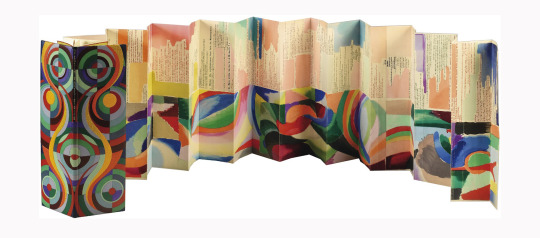
What an exciting project I have been involved in through my most recent bookbinding commission: the recreation of La Prose du Transsbérien et de la Petite Jehanne de France - the remarkable book by poet Blaise Cendrars and artist Sonia Delaunay. Sonia and Blaise first met in January of 1913 and formed an instant friendship, producing this book by letterpress and pochoir in 1913. The original book was a landmark achievement for its time and remains vibrant and modern today.
The recreation project was conceived by Kitty Maryatt, the proprietor of Two Hands Press in Playa Vista, California since 1974. In 2017 she decided to publish the recreation with the help of underwriters. Kitty has created a blog of her own documenting her journey through the process of recreating 150 editions as closely as possible to the original book by using letterpress and pochoir. Her blog is totally fascinating can be found here. It is thanks to this blog, plus some additional information that was printed to be housed with the completed book, that I am able to pass on so much information about this latest binding of mine.
The image above shows the binding made by Paul Bonet between 1963-64, sold by Christie’s in Paris on April 29, 2004 for 350,000 Euros. Sonia and Blaise had planned on making 150 copies however this was not completed.
“Was the primary reason for the incomplete edition the excessive length of time it might take to complete the pochoir process, assuming that the pochoir was the final procedure before binding? Did World War I intervene? Were there exhibits of the book, any reviews, any publicity at all? Were the sales disappointing? Did they run out of money?”
The actual number remains unknown, 74 have been identified but the list of these has never been published.
“The edition numbering system Blaise Cendrars used is somewhat random, indicating that the edition numbers were not written on the copies when they were first made. For example, there are two copies numbered 47, two numbered 111, and two numbered 139. Many copies do not have an edition number. There is a copy numbered 1 and one numbered 150.”
The La Prose of 1913 was printed on three materials: vellum, Japon and simile Japon, they stuck to the typical formula of publishing a deluxe edition and regular edition. Japon in one of many Japanese papers sold by the Japan Paper Company; simili Japon is made with Western fibres, also sold by the Japan Paper Company. The Paul Bonet binding is one of the vellum editions.
The below image shows Kitty’s recreation (right) alongside an original copy at The Getty Research Institute, Los Angeles, CA (left). This is #124, glued and folded into 21 panels, inscribed to Archipenko, the vellum cover is not attached.
“The book itself is captivating with its colorful and painterly pochoir (French-style stencil), so unlike stenciled copies of artwork at the time. The colors seep from the painted side into the poem on the other side.”
Kitty wanted to recreate the pochoir methods as closely as possible to the original using pommes (short, wide brushes) and metal stencil plates. Pochoir is a refined stencil-based technique employed to create prints or to add colour to pre-existing prints. It was most popular from the late 19th century through the 1930's with its center of activity in Paris. Numerous stencils were designed as a means of reproducing an image. (Photo courtesy of Kitty Maryatt)
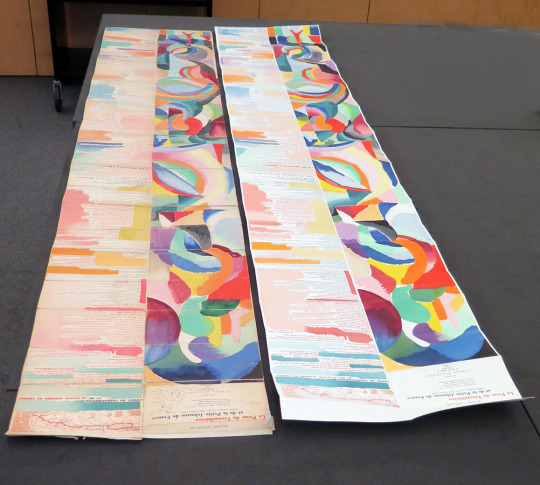
My copy was one of two that Neale Albert (New York) had underwritten and commissioned. When I received my copy of the sheets in the post (#58 0f 150) they came with three different instruction sheets of how the pages could be folded - it was rather daunting!
The long vertical format of the book was an unprecedented choice for a book of the period:
“The Trans-Siberian Railroad was begun in 1890 when Blaise Cendrars was only three years old, but it was highlighted at the 1900 Exposition Universelle in Paris that he attended with his family. The entire series of railroad lines weren't actually completed until three years after La Prose du Transsbérien was published. In the book, Blaise included a map of the journey from Moscow to Vlasivostok, which gives us a clue as to the distinctive folding scheme of the book. I've found tourist maps of Paris for the period similarly folded, in half first, and then in accordion – folded flat and glued to the cover. In the case of La Prose, as you open the book, you can't actually see anything in the book, neither the text nor the imagery, until the book is completely unfolded.”
It was up to me to choose which format I wished to use having been instructed that there was no set way of binding the book, so total creative freedom! Along with the written instructions, Kitty also sent all binders images of the folding and gluing process - crucial information to have before proceeding. There were three ways of folding the concertina, either like the original (left hand format), long and thin like the Paul Bonet binding (middle format) or double width (right hand format). (Photo courtesy of Kitty Maryatt)
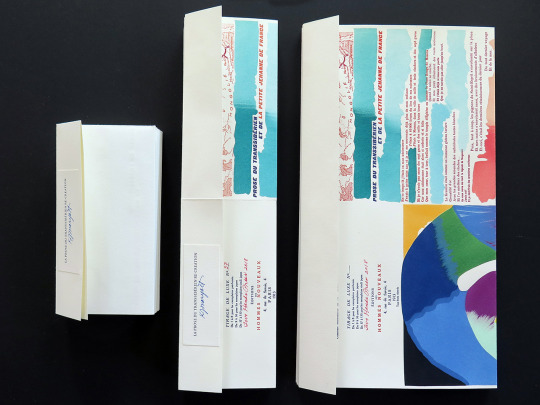
The 1913 edition book covers were painted in oils by Sonia Delaunay, some covers had a snap, which made the book resemble a purse. Kitty’s version of La Prose is bound with vellum covers however she used acrylic paint to decorate the cover as she found that the oils yellowed the vellum. The book is housed in an acrylic slipcase and is pictured below. (Photo courtesy of Kitty Maryatt)

So, the time had come to trim and stick all of my sheets together!
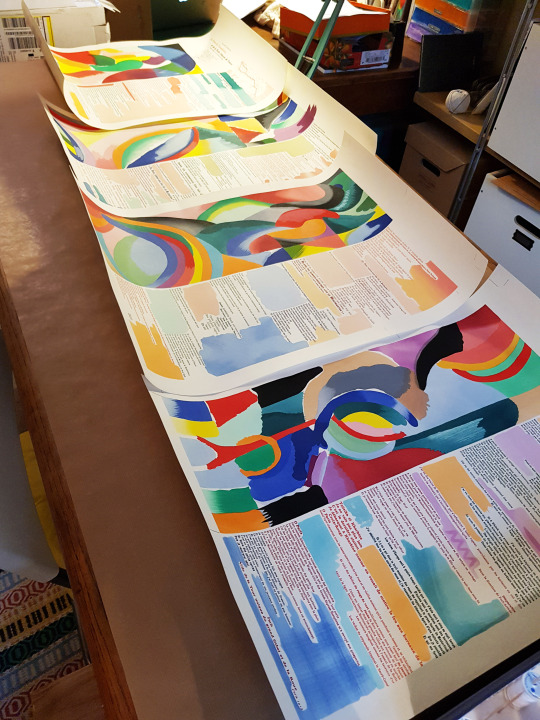
The first step was to cut all four pages to size. I am used to working in cm, I have almost never used inches, so the fact that all of the instructions were in imperial took extra brain power - I never even glance at the other side of the ruler!
The first step was to measure 7 1/18 inches from the centre fold mark at the top and bottom and to cut off one vertical side.
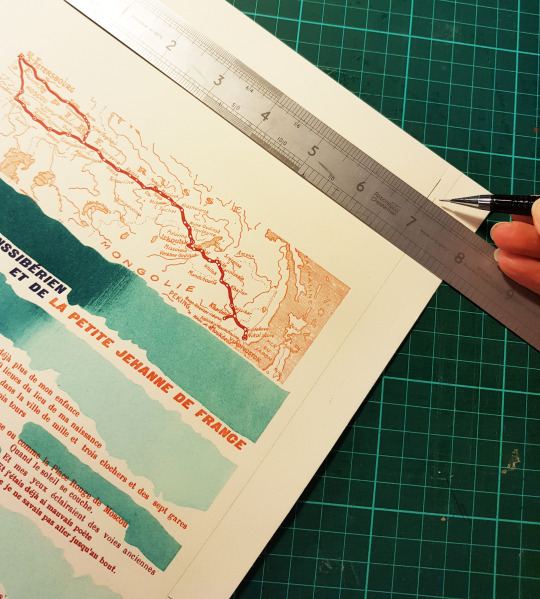
The next was to cut off the other vertical side so that the width of the page was 14 1/14 inches and the two sides were parallel.
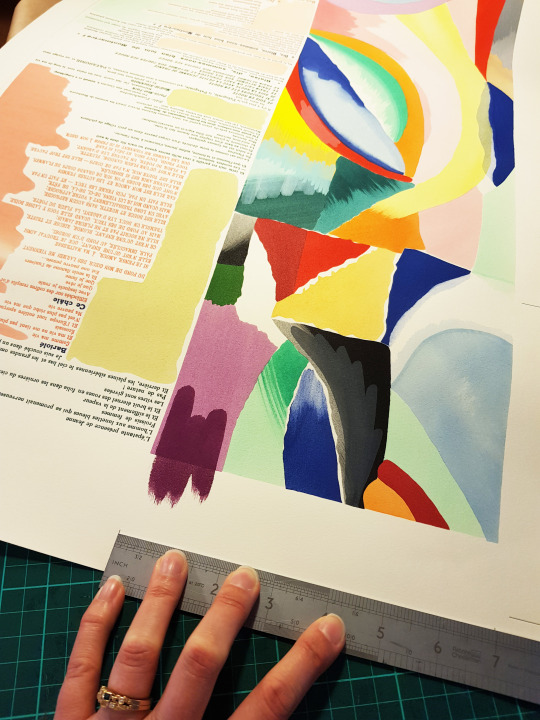
Next I had to cut off one inch at the top of page one, and to trim the top of pages 2 to 4 at the printed mark on the right side just above the first line of type. The bottoms of each page then had to be cut to meet the following lengths: Page 1 - 21.75 inches, Page 2 - 20.25 inches, Page 3 - 19.875 inches and Page 4 - 19.5 inches.
I was then able to proceed with gluing all four sheets together. I soon found I didn’t have a long enough table to work on but managed to get around that by moving two next to each other! The cut edges of the sheet were not thinned or pared in any way, they were stuck together at full thickness (the same as with the original binding).
Pages one and two were lined up along their edges, overlapping by 3/4 inch. Each page was glued to about 1/2 inch in, so that when overlapped all of the paper overlap was covered in glue. The reverse of the upper page was glued, then the front of the lower page before being combined.
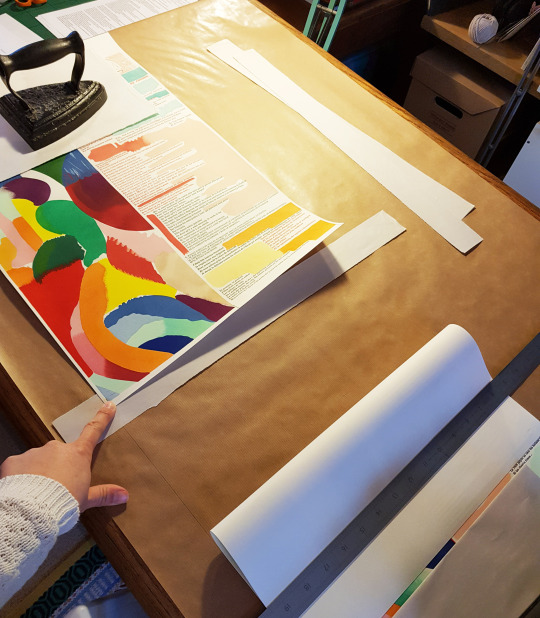
A weight was applied to the glued joint afterwards and I waited for it to dry before moving on to gluing the next joints. The instructions stated:
“Note that the images don’t line up completely at the joints. I copied the original exactly. Why did they do that? It’s odd from our perspective. The outside lines should line up pretty well if you cut to size carefully.”
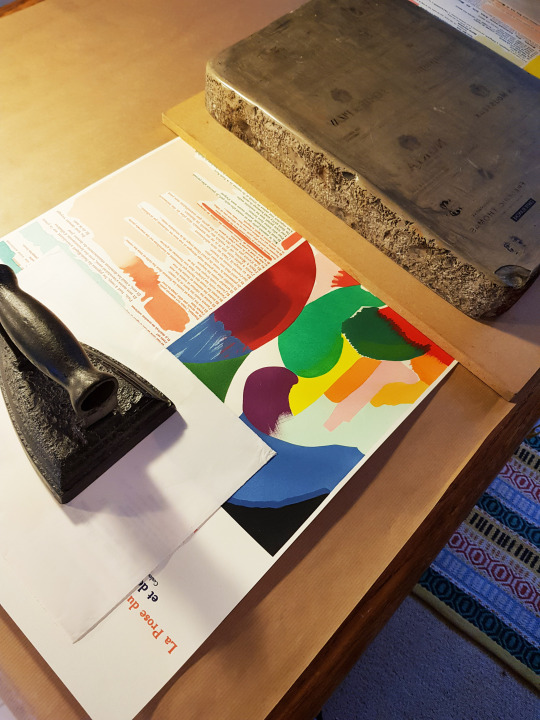
Once all four sheets were glued together is was time to start folding. Her the instructions did actually switch to being in centimetres!
“Folding: I use a jig of board cut to 197mm. I place the board on to the paper at the bottom edge, blank side up, place the ruler next to the left side of the board, remove the board, and score the paper 197mm from the bottom edge, and fold up. The next fold is 197mm from the first fold, I score on the blank side and reverse the fold (or you can flip the book if you wish). Continue until you get to the top, where you will have a tab left for attaching to your binding, if you wish.”
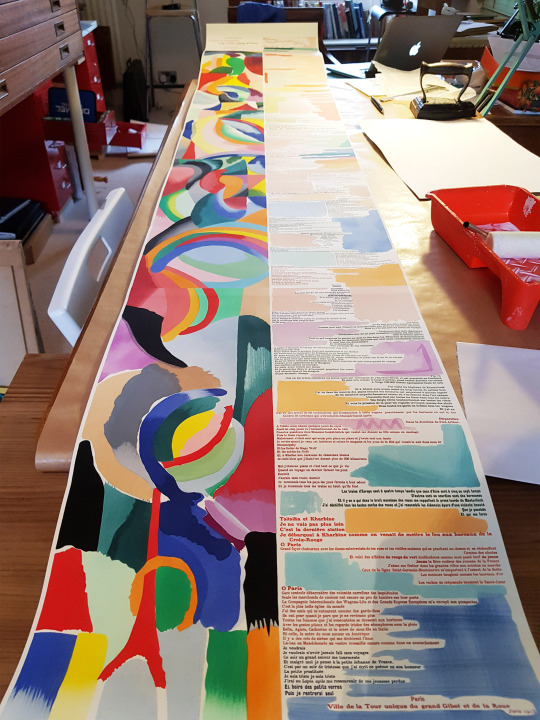
These folding instructions left me with a text block to the largest format possible. I deliberated for a long while whether to keep it at this size, but in the end took the plunge and did an additional fold in each section to give me a text block that was half the width, so the same format as that of the Paul Bonet binding.
Once I had the text block size it was time to start designing the cover. I knew that I wanted to use embroidery, as I always do, so set about making sure I had threads to match all of the wonderful pochoir colours.
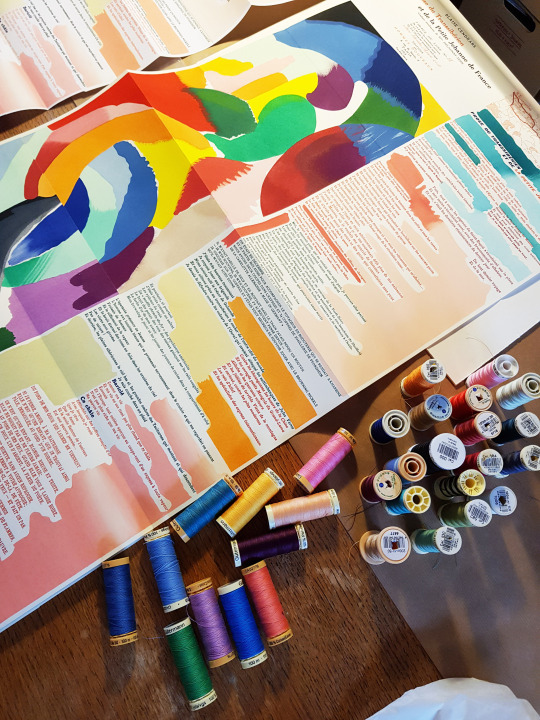
I decided to do some research into Blaise Cendrars. Blaise Cendrars was the pen-name for Fréderic Louis Sauser - a play on Braise (ember) and Cendres (ash). He was a Swiss-born novelist and poet who became a naturalised French citizen in 1916. He was a writer of considerable influence in the European modernist movement.
His writing career was interrupted by World War I, he was sent to the front line in the Somme from mid-December 1914 until February 1915. It was during the attacks in Champagne in September 1915 that Cendrars lost his right arm and was discharged from the army.
As he was right-handed, he had to learn how to write with his left hand following the war. I decided to try and find handwriting examples of his from before and after he lost his right arm which was possible online. It would have been wishful thinking to find a handwritten transcript of La Prose, however I did find some good examples of both his left and right handwriting on other documents.
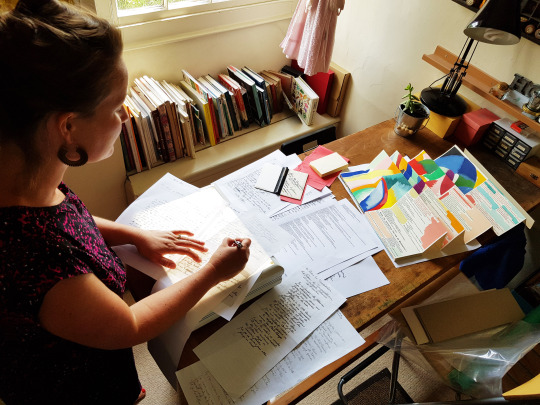
What I decided to do was to transcribe parts of the poem in each of these handwriting styles to use on the front and back of the book. I used a typed print out of the poem to refer to and found example of whole words (if possible), or individual letters, from the documents I had found, and pieced these together to try and reflect the writing style of before and after the loss of his arm - the left hand writing was more haphazard and scribbly-looking. What I couldn’t work out at first though was which should go on which cover!
I put the question to some family and friends and got some great feedback. What I hadn’t thought about before was that if I did the “before” handwriting on the front and the “after” handwriting on the back, when the book was opened up or laid flat I would have the writing on the sides which naturally correspond to the hands which were used - the decision was made.

So the “after” left handwriting became the design for the back board, and I took wording from the beginning of the poem.
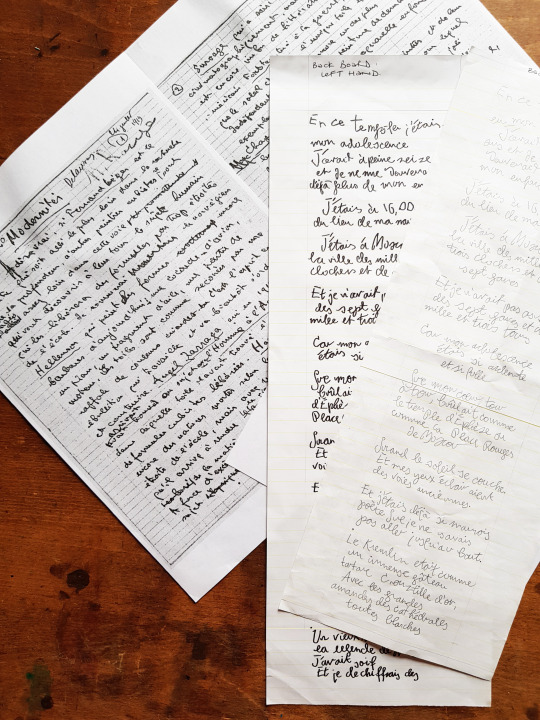
And the “before” right handwriting became the design for the back board, and I took wording from towards the end of the poem.
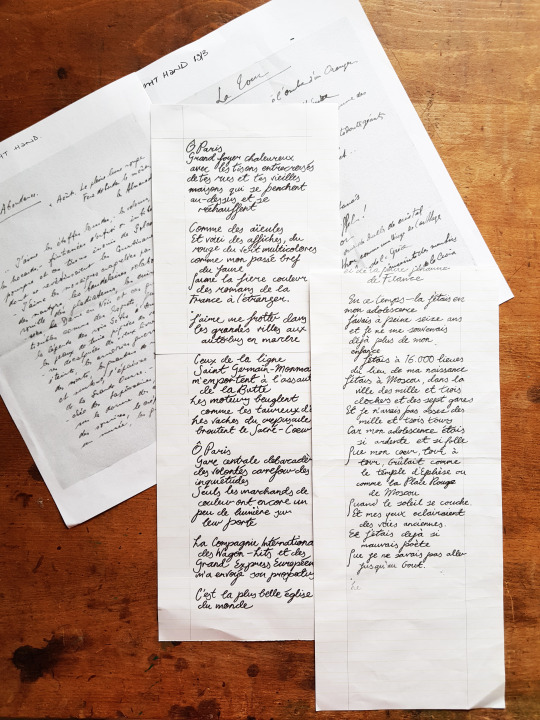
It took a few attempts to get it to the right width for the boards, and to get enough words on so that the front and back covers started and ended at the same heights. For each of the covers I photocopied the writing onto tracing paper templates so I had a master copy to work from.
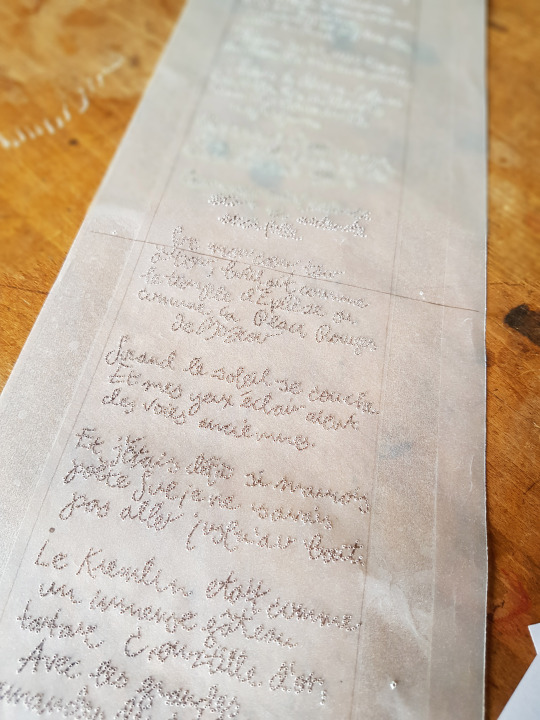
During the period of time I was working on this binding I made a trip to London to see the British Library’s exhibition entitled, Writing: Making Your Mark.
“Writing: Making Your Mark is a landmark British Library exhibition, which spans 5,000 years across the globe, exploring one of humankind’s greatest achievements – the act of writing. From carved stone inscriptions, medieval manuscripts and early printed works to beautiful calligraphy, iconic fonts and emojis, Writing: Making Your Mark (26 April – 27 August 2019) will deconstruct the act of writing and consider its future in the digital age.”

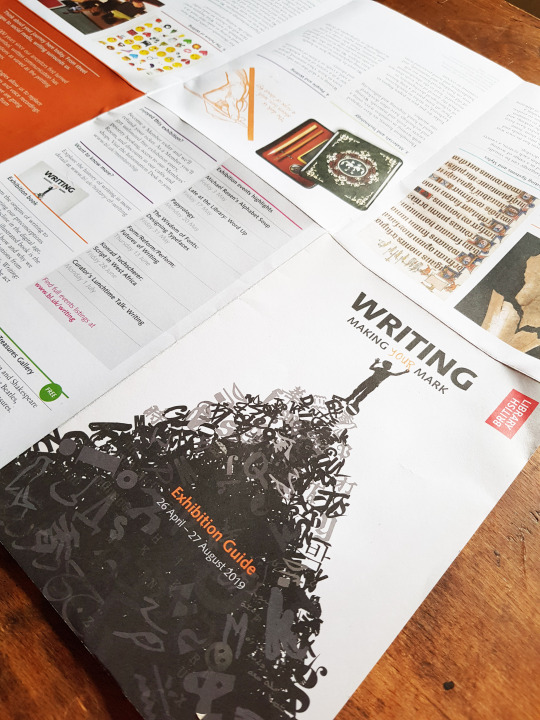
What a timely exhibition to be on whilst I was making my own mark with the handwriting of Blaise Cendrars.
“People first created writing 5000 years ago, its invention revolutionised society. Writing began in a number of locations around the world, at different times and for different reasons. People developed it to communicate across time and space, carrying it with them as they traded, migrated and conquered.”
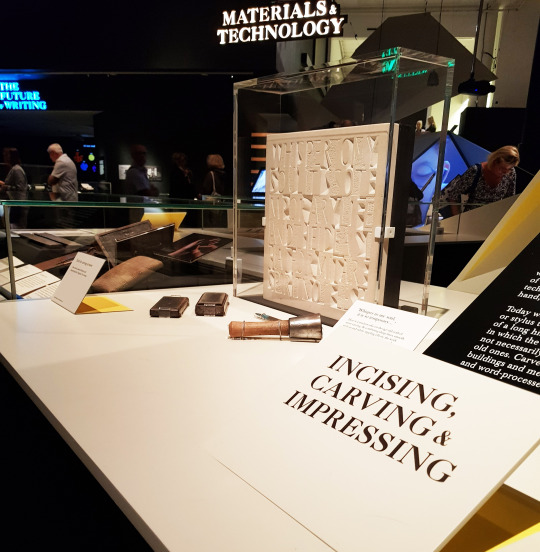
It is amazing to think that writing and technology have often developed hand in hand. What began as inscribed patterns on bones thousands of years ago has somehow led to me sitting at my computer typing away at this blog on a keyboard. I hope I have done Blaise Cendrar’s two versions of handwriting justice in my binding!
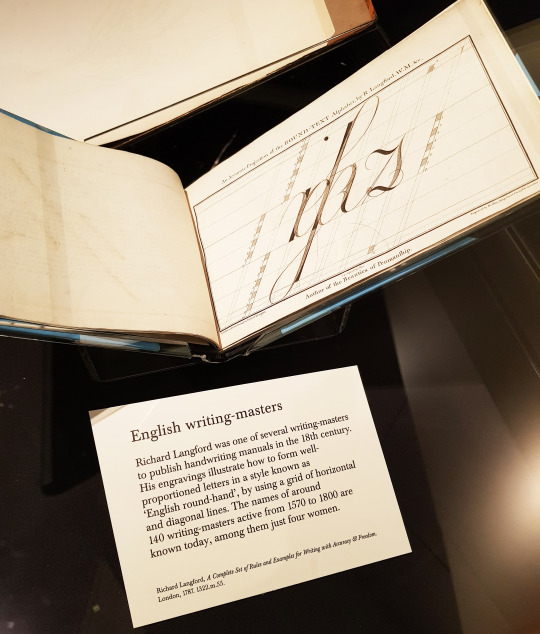
In August 2015 Kitty identified thirty-eight distinct typefaces used in La Prose.
“Blaise Cendrars printed La Prose at Imprimerie Crété in Corbeil, France because he was already in the process of printing his second book, Séquences, at Crété in early 1913. The poem is four hundred and forty-five lines long. In a brilliant and groundbreaking master stroke, Blaise decided to select dozens of typefaces for the poem.”
She was convinced that Blaise did not walk along the hundreds of type cabinets at Crété impulsively selecting type: Crété certainly would have had an in-house type catalogue to view the available typefaces.
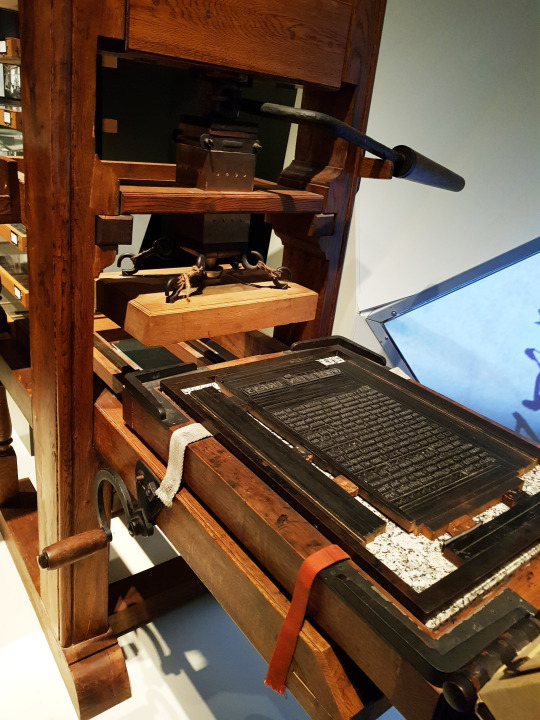
The next blog post will go through the choices I made when it came to binding such a book, “La Prose Part Two: Structure”.
#la prose#la prose du transsibérien#sonia delaunay#blaise cendrars#kitty maryatt#british library#writing#making your mark exhibition#bookbinding#bookbinding commission#reliure#reliure d'art#livre d'art#pochoir#stencilling#typesetting#handwriting#left handed#right handed#two hands press#hannah brown#hannah brown bookbinder#shepton mallet#bowlish#embroidered binding#vellum binding
8 notes
·
View notes
Text
Primary sources related to the Mongol period
Primary sources are the most important part of any historical study, for they are one of the ways that information from the past is transferred to us. In my own videos I increasingly try to make greater use of them, and to aid in the efforts and interests of others, below I will link the english (and two french) translations I have found freely accessible online. Obviously, working with primary sources in the original language is best, but very difficult for the Mongol period considering the Feel free to add any which I have not included (if anyone has found an online copy of D.S. Richard's part 3 translation of Ibn al-Athir, that would be much obliged! Likewise, for the full text of Rashid al-Din)
If any links don't work, please let me know and I'l see if I can do anything about them. I tried to keep them roughly categorized, but the Bretscheinder/Henri Yule/Hakluyt Society works at the end didn't quite fit neatly into that. If you have a question about a particular source or who it was that wrote it, also feel free to ask. I do apologize for wonky formatting (due to the transition from Google Docs to websites!) or ramshackle citation (rather spur of the moment to share it).
Hopefully this helps people interested in the period!
SECRET HISTORY OF THE MONGOLS, and MONGOL-YUAN PERIOD
Cleaves, Francis Woodman. The Secret History of the Mongols: For the First Time Done into English and out of the Original Tongue and Provided with an Exegetical Commentary. Translated by Francis Woodman Cleaves. London: Harvard University Press, 1982. http://altaica.ru/SECRET/cleaves_shI.pdf
de Rachewiltz, Igor. The Secret History of the Mongols: A Mongolian Epic Chronicle of the Thirteenth Century. Translated by Igor de Rachewiltz. Edited by John C. Street. University of Wisconsin: Madison, 2015. http://cedar.wwu.edu/cgi/viewcontent.cgi?article=1003&context=cedarbooks (without his extensive annotations, unfortunately)
Kahn, Paul. The Secret History of the Mongols: The Origin of Chingis Khan (Expanded Edition) An adaption of the Yüan Ch’ao Pi Shih, Based Primarily on the English Translation by Francis Woodman Cleaves. Translated by Francis Woodman Cleaves. Cheng and Tsui Company: Boston, 1984. https://books.google.ca/books?id=GKCtl8BLaEsC&pg=PA191&dq=alan+guard+mongols&hl=en&sa=X&redir_esc=y#v=onepage&q=alan%20guard%20mongols&f=false
Onon, Urgunge. The Secret History of the Mongols: The Life and Times of Chinggis Khan. Translated by Urgunge Onon. RoutledgeCurzon Press: Abingdon, 2001. https://jigjids.files.wordpress.com/2011/05/the_secret_history_of_the_mongols_the_life_and_times_of_chinggis_khan1.pdf.
Kenneth W. Chase, “Mongol intentions towards Japan in 1266: Evidence from a Mongol letter to the Sung.” http://chinajapan.org/articles/09.2/09.2chase13-23.pdf
The Monks of Kublai Khan, Emperor of China or The History of the Life and Travels of Rabban Sawma, Envoy and Plenipotentiary of the Mongol Khans to the Kings of Europe, and Markos Who as Mar Yahbh-Allaha III Became Patriarch of the Church of the East in Asia. Translated by E.A Wallis Budge. London: Religious Tract Society: 1928. http://www.aina.org/books/mokk/mokk.htm
RUS
The Chronicle of Novgorod 1016-1471. Translated by Robert Michell and Nevill Forbes. Camden Third Series: London, 1914. http://faculty.washington.edu/dwaugh/rus/texts/MF1914.pdf
ARABIC
al-Maqrizi. Histoire des sultans Mamlouks de l’Égypte. Translated by Étienne Marc Quatremère. Paris: Oriental Translation fund of Great Britain and Ireland, 1845. https://archive.org/details/histoiredessulta01maqr
al-Nasawi, History of the Sulan Jelal al-Din Mingburnu, translated by O. Houdas http://remacle.org/bloodwolf/arabe/nesawi/sultan.htm (In french, but google translate did the site to a reasonable degree for me)
Juzjani. Ṭabaḳāt-i-Nāṣirï: A General History of the Muhammadan Dynasties of Asia. Vol. I. Translated by H.G Raverty. London: Gilbert & Rivington, 1881. https://archive.org/stream/in.ernet.dli.2015.23988?ui=embed#page/n5/mode/2up
Juzjani. Ṭabaḳāt-i-Nāṣirï: A General History of the Muhammadan Dynasties of Asia. Vol. II. Translated by H.G Raverty. London: Gilbert & Rivington, 1881. https://archive.org/stream/in.ernet.dli.2015.211407?ui=embed#page/n5/mode/2up
ARMENIAN
Kirakos Gandzakets'i's, History of the Armenians. Translated by Robert Bedrosian. 1996. https://archive.org/details/KirakosGanjaketsisHistoryOfTheArmenians
http://rbedrosian.com/kgtoc.html
Vardan Arewelt’si, Compilation of History. Translated by Robert Bedrosian.
https://archive.org/details/VardanAreweltsisCompilationOfHistory
http://rbedrosian.com/vaint.htm
Grigor Aknerts’i, History of the Nation of Archers. Translated by Robert Bedrosian. https://archive.org/details/GrigorAknertsisHistoryOfTheNationOfArchersmongols
Het’um of Corycus History of the Tartars/ The Flower of the Histories of the East. Translated by Robert Bedrosian. http://www.attalus.org/armenian/hetumtoc.html
King Hetum II’s Chronicle. Translated by Robert Bedrosian. https://archive.org/details/KingHetumIisChronicle
“The Journey of Het’um I, King of Little Armenia, to the Court of the Great Khan Mongke.” Translated by John Andrew Boyle.https://archive.org/details/KingHetumIisChronicle
https://archive.org/stream/Boyle1964Hetum/Boyle_1964_Hetum#mode/2up
Smbat Sparapet. Chronicle of the Kingdom of Little Armenia. Translated by Robert Bedrosian.
http://rbedrosian.com/cssint.htm
Smbat Sparapet. “Letter of Smbat Constable to Henry I of Cyprus, ca.1248.” Cathay and the Way Thither. Edited by Sir Henry Yule. London: Hakluyt Society, 1915. 262-263.
http://rbedrosian.com/lsmbat.htm
Step’annos Orbelean. History of the State of Sisakan. Translated by Robert Bedrosian.
http://rbedrosian.com/SO/sotoc.html
SYRIAC
Bar Hebraeus http://www.syriacstudies.com/AFSS/Syriac_Books_in_English/Entries/2009/9/30_Bar_Hebraeus_Chronography.html
PERSIAN/ILKHANATE
Hamadani, Rashid-al-din. The Successors of Genghis Khan. Translated by John Andrew Boyle. New York: Columbia University Press, 1971. https://archive.org/details/Boyle1971RashidAlDin. (not the full text of Rashid al-Din)
‘Ala-ad-Din ‘Ata-Malik Juvaini, The History of the World-Conqueror. Vol. I. Translated by John Andrew Boyle. Harvard: Harvard University Press, 1958. https://archive.org/details/historyoftheworl011691mbp/page/n8
‘Ala-ad-Din ‘Ata-Malik Juvaini, The History of the World-Conqueror. Vol. II. Translated by John Andrew Boyle. Harvard: Harvard University Press, 1958. https://archive.org/stream/historyoftheworl011648mbp?ui=embed#page/n8/mode/2up
CHAGATAI TURKIC
Mirza Muhammad Haidar Duglught Beg, Tarikh-i-Rashidi. (1500-1551) Chagatai Turko-Mongol general, ruler of Kashmir, first cousin of Babur. Wrote history of Timur’s conquests, Moghulistan.https://archive.org/details/TheTarikh-i-rashidi
EUROPEAN
Matthew Paris’s English History From the Year 1235-1273: Vol I. Translated by John A. Giles. London: Bohn’s Antiquarian Library, 1852. https://archive.org/stream/matthewparisseng01pari#page/n7/mode/2up
Matthew Paris vol II. https://archive.org/stream/matthewparisseng02pari#page/n5/mode/2up
Matthew Paris Vol III. https://archive.org/stream/matthewparisseng03pari#page/n3/mode/2up
(Paris mentions the Mongol invasions of Hungary in one of these volumes, but I couldn't remember which)
de Joinville, Jean. The Memoirs of the Lord of Joinville: A New English Version. Translated by Ethel Wedgewood. E.P Dutton and Co.: New York, 1906.
http://web.archive.org/web/20081011222823/http://etext.lib.virginia.edu/toc/modeng/public/WedLord.html
The Text and Versions of John de Plano Carpini and William de Rubruquis as printed for the first time by Hakluyt in 1598 together with some shorter pieces. Edited by C. Raymond Beazley. London: Hakluyt Society, 1903.
https://archive.org/stream/textsversionsofj00hakluoft#page/38/mode/2up
Polo, Marco. The Book of Ser Marco Polo, The Venetian: Concerning the Kingdoms and Marvels of the East. Translated by Henry Yule. London: John Murray, Albemarle Street, 1871. Vol 1. https://archive.org/details/bookofsermarcopo01polo.
Vol 2. https://archive.org/details/bookofsermarcopo02polo.
COLLECTIONS, VARIOUS.
Bretschneider, Medieval Research on Eastern Asiatic Sources, vol. I
https://archive.org/details/in.gov.ignca.10001/page/n7 (Extract from Yelu Chucai; Wu-ku-sun (1221-1224) Jin envoy to Mongols; Chang-chun; Si shi Ki (Ch’ang te); Ye-lu Hu Liang)
Bretschneider, vol. II
https://archive.org/details/in.gov.ignca.10013/page/n7
Bretschneider, Notes on Chinese Medieval Travellers to the West, 1875
https://play.google.com/books/reader?id=QwXwHwwtnYYC&hl=en&pg=GBS.PP9
(Si yu ki, Ch’ang-ch’un, 1221-1224; Si shi ki, Record of an embassy to the regions in the west, 1259-60; Pei shi ki, Wu-ku-sun account, 1220-1221; Extract from Si yu lu, Yelu Chucai 1219-1224)
Cathay and the Way Thither: Being a Collection of Medieval Notices of China. Translated by Henry Yule. Edited by Henri Cordier. Vol. 2. London: The Hakluyt Society, 1913. (Odoric of Pordenone.)
https://archive.org/stream/cathaywaythither02yule#page/n9/mode/2up.
Cathay and the Way Thither: Being a Collection of Medieval Notices of China. Translated by Henry Yule. Edited by Henri Cordier. Vol. 3. London: The Hakluyt Society, 1914. Missionary Friars (John of Montecorvino, Andrew Bishop of Zayton, Jordanus, Pasca of Vittoria)-(Rashid al-Din, when he discusses China)-Pegolotti -Marignolli https://archive.org/details/cathaywaythither03yule.
Cathay and the Way Thither: Being a Collection of Medieval Notices of China. Translated by Henry Yule. Edited by Henri Cordier. Vol. 4. London: The Hakluyt Society, 1916. Ibn Battuta (section of his works pertaining to China)- Benedict Goёs (1600s) https://archive.org/details/cathaywaythither04yule.
#primary sources#mongol empire#chinggis khan#secret history of the mongols#history#resource#china#european history#chinese history#persia#medieval
17 notes
·
View notes
Text
Grimoire: The Sacred Grammar of Magick
Or how to add a little something extra to your GriMORE (heh)
Puns aside, lets begin...
Firstly, what is a Grimoire?
"The derivation of 'grimoire' is not entirely certain. In the early nineteeth century it was suggested that it came from the Italian 'rimario', a book of rhymes or Bible verses. It more likely derives from the French word 'grammaire', which originally referred to a work written in Latin. By the eighteenth century it was being widely used in France to refer to magic books..."
- Davies, Owen (2009). Grimoires: A History of Magic Books
A book of magic spells and invocations. Origin- Mid 19th century: French, alteration of grammaire ‘grammar’.
-Oxford English Dictionary
Despite its original derivation not being certain, it is known that the most common modern association is with the French word ‘grammaire’. It was during the 18th and 19th centuries that France allowed a way for Grimoires to become more available to the general public with the use of Bibliothèque bleue (blue library). This wider publication also increased the interest in occultism among the British following the publication of Francis Barrett's The Magus in the early 19th century, the term entered the English language in reference to books of magic( Davies, Owen (2009). Grimoires: A History of Magic Books).
It was because of these various factors that the word ‘Grimoire’ began to be used as a more general reference of magical books and texts, vs what it had been before as a word describing magical texts that were typically written in Latin.
And in the more modern sense, grimoire is certainly a word used to describe any book of magic.
That all said, there are certainly many magical books and texts that are similar to grimoires or that could easily be labelled as grimoires; however, not all magical books are grimoires.
Per Owen Davies, a grimoires is “...being based on the conjuration of spirits, the power of words, or the ritual creation of magical objects.”
A VERY Brief History
The history of grimoires can be laid out in the following: Ancient period, Medieval period, Early Modern (with a special note for the 18th and 19th century), and modern day.
The Ancient period constitutes as pre the Fall of the Roman empire.. It was during this long time frame that European Grimoires took great inspiration from. Specifically, it was the ancient civilizations that surrounded the Mediterranean and middle east, and countries within the middle east. Particularly, the religious traditions of various pagan practices, Judaism, Christianity, and Islam were some of the greatest influences on Medieval European grimoires.
The Medieval period marked the period of what folks would label as the “classical” grimoires. Despite the rise of Christianity and the Church attempting to stomp out all pagan worship, it was never able to mark a clear line between religious worship and magical working, “ The use of such books on magic continued. In Christianised Europe, the Church divided books of magic into two kinds: those that dealt with "natural magic" and those that dealt in "demonic magic,” (Davies, Owen (2009) Grimoires: A History of Magic Books).
In the Early Modern period, grimoires had become more common place and known within society. The Renaissance had fueled the increase interest and pursuit of Medieval grimoires, as well as a rise of interest in Hermeticism, Judaic Mysticism, and the occult.
And with the rise and improvement of printing in Europe, which soon resulted in mass printing, allowed for more exposure towards the general populace.
Particularly during the 18th and 19th century, grimoires had become mass produced and widely available across western Europe (especially within France).
Due to this increase of interested in folklore, mysticims, and the occult, many historians took an interest in magic and in grimoires. Many even went on to publish snippets of grimoires within their own history books.
In the late 19th century, many famous grimoires (such as the Key of Solomon) were reclaimed by various magical groups, the OTO and Golden Dawn being some famous examples.
In Modern Day, we find that access to many ancient and more recent grimoires are far easier to access, than they ever have been before.
One can easily log into sites (such as sacred-texts.com) and view a number of different grimoires and magical texts for free. And even before the internet, many books and texts could be found in the local library or purchased.
This has resulted in the rise of many new magical groups, traditions, and societies (even the resurrection of old ones). There are many modern day grimoires that have become quite popular and influential to the magical scene, pulling from both historical information as well as new found knowledge and experience: such as Azoetia and The Dragon Book of Essex.
Here is a generalized interactive timeline of grimoires throughout the centuries
Famous Grimoires
There are dozens and dozens of grimoires out there (here have a list), way too many to mention all in one post. So instead, I will briefly talk about some of the more famous, influential, and well known ones. So please, do forgive me if I leave out a few important ones.
-
The Keys Of Solomon (Greater and Lesser)
Perhaps one of the most influential and well known grimoires, The Key of Solomon is a 16th century grimoire which gives a thorough description of the process of summoning a spirit, with chapters on the various supplies the magician will require, and the tasks they must perform. -X
The Lesser Key is one of the best-known grimoires, primarily for the first section, the Goetia, which features charming descriptions of the 72 demons conjured by Solomon, along with illustrations of their sigils, and the tools required for summoning. -X
Unlike the Key of Solomon, the Lesser key contains content from multiple different books.
The original texts having been written in Latin, these are truly is the idea of what a grimoires is in every sense. Their influence is widespread both historically and magically speaking. Find yourself in a group with a random bunch of occultists, and you’ll easily find a dozen pulling from these books.
-
Petit Albert
Le Petit Albert is an French grimoire that has gained some degree of fame or infamy. It lists a number of spells for results such as dental health and invisibility. -X
Though not quite as famous or influential compared to some grimiores. Petit Albert still had a large mark on the modern development of the grimoires and folklore of magic. It included instructions on making a Hand of Glorey.
But most of all, it marked a historical importance of the mass print. It was one of the first widely available grimoires in France.
-
The Sixth and Seventh Books of Moses
This grimoire is an important text of folk magic from the German tradition. It was first published by Johann Scheible in Germany in 1849, and in New York in 1880, although versions circulated in Western Europe in pamphlet form as early as the 18th century. -X
The Sixth and Seventh books of Moses had a particular influence in both Europe as well as America, used within Appalachian and Pennsylvanian Dutch magical practices. They even circulated within Scandinavia and Central Europe and were at times referred to as “Black Bibles.” Though with this one, I have not seen a valid source given, aside from “Versions of this work circulated throughout Scandinavia and Central Europe. In Sweden and Finland these books are compiled and published under the titles Den Svarta Bibeln and Musta Raamattu, respectively, meaning "The Black Bible". found on various sites like Wikipedia.
-
The Magus
Francis Barret's The Magus is a compilation of magic, alchemy, and accounts of historical magical adepts, which copies extensively from Agrippa's The Books of Occult Philosophy, The Fourth Book of Occult Philosophy, and the Heptameron.
It is a foundation text of the occult revival, and is thought to have influenced the work of later occultists such as Eliphas Levi. -X
If Petit Albert marked the moment of cheap mass producing, The Magus marked the moment that grimoires were beginning to be translated into English and later being mass produced.
-
The Book of Shadows
Not necessarily a single specific grimoire or text, the Book of Shadows is a book containing religious texts and instructions for magical rituals specific towards Wicca, a religious tradition of Witchcraft and Paganism.
I assume that a lot of people’s first interaction with a grimoire or mention of one is via a Book of Shadows. Today, Wicca, and its related traditions, are a lot of folks’ first step into the magical and occult communities.
Despite its name, a Book of Shadows is exactly the same as a Grimiore. Doreen Valiented stated in “The Rebirth of Witchcraft” that most likely Gardner adopted the term for his Witches' grimoire (The Book of Shadows) from an article found in The Occult Observer V1 N3 1949.
Applying this knowledge to your own Grimoire
So you know a thing or two about Grimoires, what now?
You can create your own of course.
How? I see this appear all over the place online, as well as get asked occasionally by folks in person.
At the end of the day, a Grimoire is a magical book containing information about a person’s personal practice. It can even be an instructional guide if desired.
Its looks how you want it to be, it contains what you want and need, and it acts for whatever purposes you need.
That said, this doesn’t help a lot when a person has no idea what to do or what to put in it. So, I will provide some more ample advice.
1. - Look towards other grimoires for inspiration and reference
A number of historical grimoires already do this, so why not you? Look at how these grimoires are organized. What do they contain? How are they framed?
As an example, lets take a look at the Lesser Key of Solomon
Opening invocation
Initiation
Definitions
Lists of Spirits (the 72 demons)
magical seals
specific rites
You might include an opening charm or invocation at the beginning of your Grimoire. In certain books, such as Long Lost Friends, the tome begins with a written charm of protection for the carrier of the book. Others might include a written hex or curse to ward unwanted readers.
You might include such rites as an initiation (if you have one), specific rituals of importance (such as a rite of banishment or cleansing), etc.
A page of reference for definitions and specific might also be helpful. Lets say you reference a recipe for oil often, but don’t want to write it down every time. You can have a page that has it once, then reference that other times.
Next, you might want to list specific about spirits and various entities. I’d suggest straying away from ones that tend to be common knowledge. Stick more to personalized things that you want to remember and can’t find from a quick google search.
Magical seals can include anything from privately created ones, or even well known ones. These can act as a reference for future use, or even as physically written charms in their own right. The Grimoire is not only a book of magic, it is a magical book.
2. - Decide how it will be written
Are you going to write it in a more factual and straight forward practical piece? Is it going to act as a teacher’s manual? Is it going to be vague and hard to read, so that only the writer can understand it? Is it going to be written as a story (Such as the Black Pullet)? Is it going to consist mostly of art and only a little bit of text?
Think about how it will be laid out on the paper. There is more ways to write a grimoire than simply a book of charms and spells.
3. - Avoid putting in common knowledge
Don’t put in something that you can easily search for online. Put in things that are personal to you, things you won’t find online (or at least easily), things that are secret.
In my experience, I found that I got disappointed with old magical journals that held a bunch of stuff, but all that knowledge I could easily find on my phone or in one of my books. It left me feeling unsatisfied and I often gave up finishing the journal completely.
When I started to put more personalized things, more secret things, things you couldn’t find anywhere else, I felt satisfied. The same could be said of others.
4. - Don’t worry about organization
A lot of the old historical grimoires were a strange conglomeration of information, lore, and art. They have no real rhyme or reason behind how they were organized (or maybe they did haha).
Don’t worry too much about being exact and perfect with your organization. I find that if I worry too much about that I will never end up writing anything down.
Get it down first. You can later reorganize by re-writing it, taking out the pages and putting them into a 3 ring binder, rebinding the book with a new order, or copying the pages and organizing them into a PDF or a separate copy.
Just get it down.
5. - Its for you. Make sure its useful
Having a grimoire is fun and wonderful, but if its not useful for you it will never get finished/used. Make sure you’re writing it for yourself.
I sometimes find it helpful to imagine that I will pass it down to my children or a student. How useful would they find it?
6. - Make it an act of magic
A grimoire is a book of magic, but it is also a magical book. Make the act of writing it magical. Make it apart of your ritual and practice. Infuse it with your power and desire. It’ll help make things easier.
Use it for automatic writing, use it for trance art. Allow your tradition to fuel its creation.
The Grimoire cultus and magical art is something that will easily continue onward throughout modern time, even with the push towards digitization. Its built from hundreds and hundreds of years of lore and reference. And, I imagine it will continue to grow as more people are creating their own, both for public use and private study.
For further reading on Grimoires, I would suggest the following
Grimoires: A History of Magic Books by Daives Owen
https://www.grimoire.org/
http://www.sacred-texts.com
650 notes
·
View notes